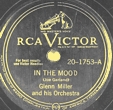
In the Mood
I had brief periods of consciousness in the womb:
- I saw the color red.
- I heard stomach noises.
- My eyes opened briefly and I saw blood vessels.
- I faintly heard part of the song "In the Mood" by Glenn Miller (dad's favorite song at the time).
When I was born I did not like what I heard and saw (hospital tiled walls with awful echoes, PA calling doctors).
When I was taken home, I heard the music again and it was much better.
I did not have any recollection of these memories until a pro-life pastor suggested that people look for them.
.....
They had a nice set of gifts for the first baby born in the new hospital.
Of course, I was the last baby born in the old hospital.
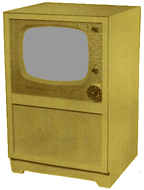
My father was a television engineer for Westinghouse in Sunbury PA.
There was no TV station near Sunbury.
He was given a TV set (right) and asked to find out what was needed to get a TV signal.
He created a tuned Yagi antenna to receive the station in Harrisburg 50 miles away.
He mounted the antenna in the attic of our apartment building.
We were the first family in town with a TV set.

We lived on the main street in town in a second floor apartment.
One day when I was about 2, we heard music outside.
Mom took me to the window and we watched a parade with bands and floats go by.
The next day I heard music, and ran to the window to see the parade. There was nothing there.
I asked mom "parade?" She said, "No. That's the radio." Then she showed me the kitchen radio.
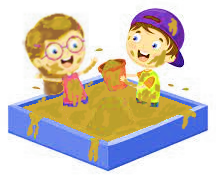
We had moved to Indiana.
My mother was studying for exams in extra classes she took to become a substitute teacher. So she wanted quiet.
My father was at work. When a friend came over to play, mother told us to not play anywhere except in the sandbox.
When we got to the sandbox, it was full of rainwater. The water was invisible from the window in the house.
We went back to the house and said we couldn't play in the sandbox.
We were told we would be spanked if we played anywhere except in the sandbox.
So we got in the sandbox and got soaked. We played there for two hours.
Finally mother came out and realized what happened. She said she was sorry, and took us to the porch to dry in the sun.

Indian Style
In my kindergarten class, the teacher told all of the pupils to "sit Indian style" (a yoga position, as at right).
I could not do it. My legs would not bend that way. The teacher tried to push my legs into that position and it hurt.
The teacher then let me sit in a different way with my feet on either side of my hips (which many others can't do).
I was born with rotated joints. All 4 of my major hinge joints (elbows and knees) are rotated 45° to their normal angles.
- The normal alignment of all joints in the arm and leg is that the joint axes are
all parallel to each other.
The axes in my elbows and knees are turned 45° to the other joints. - A normal arm hangs with the elbow ready to bend forward and the thumb pointing at
the leg.
My arm hangs with the elbow ready to bend in front of the chest 45° and the thumb pointing at the leg.
If I bend my elbow straight forward, my thumb rotates to point upward 45° toward the chest.
When sitting at a table eating, I cannot hold silverware horizontally in the customary way. But if I stand or lean over, I can do it. - A normal leg has the knee ready to bend straight backward and the foot pointing
straight forward.
My leg has the knee ready to bend back and outward 45° and the foot pointing straight forward.
If I sit with my legs bent down (by gravity), my feet point outward 45°.
When I drive or ride a bicycle, my feet point outward. If I try to point my feet forward, my knees don't work right. - My velum (soft palate) is not long enough to seal, so I have a nasal voice and can't swim underwater without a nose clip.
- I have stenosis (narrowing) of the helicotrema (low-frequency vent) in both inner ears. Infrasonic sounds are very painful to me.
- My feet are too short for standard heeled socks. The heels end up behind my ankles. I used tube socks until they stopped making them.

My mother was driving us in the kindergarten carpool.
A stone-hauling truck ahead of us had mechanical troubles. It could not pull the truck up the hill.
The truck's brakes would not hold the load of stone on the hill. It rolled backwards.
The truck driver got out of the cab to put chocks under the wheels.
The truck wheel ran over the driver, killing him (I didn't see this - I was on the other side of the car).
The truck continued to slowly roll back until it hit the front of our car.
Nobody in the car was seriously hurt. The front end of the car was smashed in.

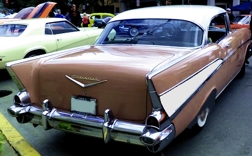
They set up a mass-immunization site in 1957 in the school I went to kindergarten in. It was one of the first ever.
Every child in the school was forced to receive two injections.
My arm was swollen up to three times its normal size for three days.
My allergist told me in 1986 that I probably got the early vaccines that did not have the virus growth media filtered out.
He said I became immune to those media. So I am permanently allergic to wheat, eggs, soy, milk, and latex rubber.
There was one consolation:
My father ordered a new 1957 Chevrolet at the dealer that same day
to replace the wrecked car (above).
I drove it many years later when I learned to drive. We had that
car 21 years.
This car had the shiftless
Turboglide transmission.
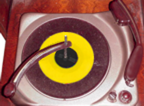
At my grandparents' house I got a kid's 78 version of Perry Como's "Round and Round." and wanted to play it.
My grandfather had a V-M 407 record changer. It has 4 speed-size positions:
45 7 LP 7 LP 10-12 STD
These were 7-inch 45, 7-inch 33, 10-12-inch 33, and 10-12-inch 78.
The changer could take 10-inch and 12-inch records intermixed.
My father (F) and grandfather (G) got into a small discussion while trying to play it.
(G) "Turn the knob here! It's a 78!"
(F) "No, turn it here. It's a 7-inch record!"
(G) "But that's 33!"
(F) "We'll turn it there, then turn it to 78 once the arm sets down!"
"PSSSSSSSSSSH!"
(F) "Something's wrong, it missed the edge of the record!"
(G) "Try the 45 position."
"PSSSSSSSSSSH!"
(F) "It still missed. This record seems too small."
(G) "Let me get a ruler."
---- ---- ---- ----
(F) "Turn it to 78. This is a 6-inch record. We'll have to play it manually!"
I wondered why it could not get it right. But see items below on how to get it right.


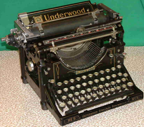

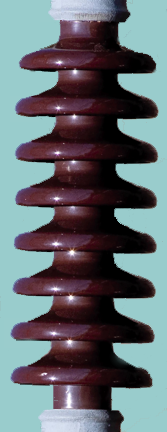
A wordsmith is someone who invents words. Here are a few of my early ones:
Spoot - The dull sound the end-of-line bell (inset) on our Underwood typewriter (right) made
Centid - My thought-word for a half-full glass
Dwet - The sound an organ makes at the end of Now I Lay Me on a record I have
Blig - The sound an organ makes when very short notes are played.
Plick - The sound of the process of cars choosing lanes on a (toy) road
Postphone - Use a telephone to postpone a meeting
Spootledop - A tall red pole with a red disc on top (right) showing golfers to the hidden green spawned this word.
Sloke - slowpoke
Demp - The sound of a single bounce of a basketball
Bimb - A large spherical lampshade or globe
Choon - One of the conical insulation sections stacked to hold up a high voltage power line (right)
Muda - A trumpet-mute shaped lamp globe usually found in an old government building (right)
Sneakret - A sneaky secret (e.g. 'sneakret agent')
Cliptomaniac - A kleptomaniac who steals only paper clips
Misteak - A mistake within a mistake
I have created thousands more words since then.
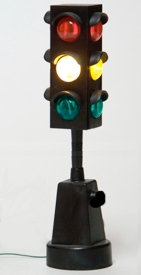
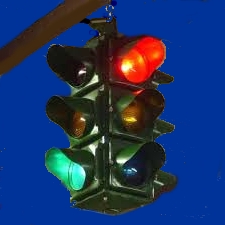
A neighbor boy got a 3-foot tall toy plastic traffic light for his birthday (left).
(I could not find a photo of the exact signal. The original one was white instead of black and the base was a rectangular box.)
All of the lights the same color came on at the same time in all four directions.
(This is because there was only one 15 watt bulb for each color shining through all four lenses. The yellow is on in the photo.)
The round knob on the base selected red, yellow, green, or off.
I realized that this had to be wrong. Traffic on each street is stopped so traffic on the other street can go.
A real traffic light is shown at right.
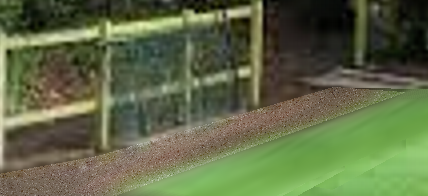
A neighbor girl and I had been digging in a fallow garden strip that was similar to the one shown.
I buried one of her toys and told her as a game to try and find it.
Instead of trying to find it, she ran crying to her father, saying I hid it.
My father told me to come to him. I got up and walked to where he was sitting.
He then told me to go dig it up and give it to her.
I started to run back to get it. Then I stopped. I had no idea where along the strip I had been sitting.
If I had not walked to where he was sitting, I would have known exactly where the toy was.
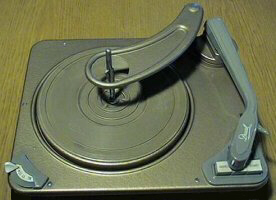
My father took us to one of his co-workers' house.
The co-worker had just bought a new Dual 1004 record changer.
This changer uses a feeler wheel in the tonearm to find the exact size of the top record on the turntable.
The feeler wheel scans the top record on the turntable from inside to outside.
I realized that this changer could take odd sized records intermixed in any size order.
This was one of the very few changers ever made that could play that 6-inch record (above) automatically
(but I would not know this until 1967 when I got access to a large Sams Photofact library).
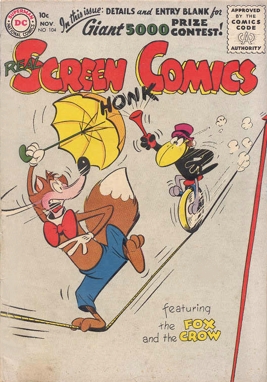
We were studying Phonics in first grade in fall 1957 and we had just done the letter 'P'.
I had been making a table on the mimeo handout we all got of all the sounds of all of the letters we learned so far.
I woke up the next morning and saw words everywhere in the room where I had not noticed them the previous day.
I automatically saw and read words on this comic book I got the day before (right). The first thing I noticed was "HONK".
(Right click the image and choose 'View Image" for bigger version.)
This driver also automatically gave me pronunciations and meanings of words I knew.
Words have automatically read themselves for me ever since.
My mind had created what computer people call a device driver that reads text. I am still using it. Words still read themselves.
Apparently people being taught the Whole Language System don't create a compact device driver like this.
I have several other device drivers in my brain, including math, geometry, locomotion, keyboards, Spanish, and sound location.

Flying Hula-Hoop rings chased me through the yard and then tried to melt through my bedroom window when I was inside.
The rings were (in the order they came) red, orange, yellow, green, blue, and violet, silent, and about 2 feet in diameter.
They were coming toward me face-on in an undulating path (imagine an invisible worm wearing six colored belts).
Then I woke up. It was a dream! I was about 8 years old at the time.
What I want to know is how my mind came up with this when I had never seen anything even remotely like it.
I also want to know how my mind knew that glass could melt. I never knew that before.
I do note that the colors were the (now obsolete) pigment primaries and secondaries taught in lower grades in school.
The colors were a learned portion of the dream.
.....
I also had a dream where light fixtures were walking around on the ceiling on jointed metal bird legs.
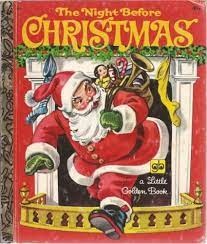
This was a Little Golden Book published in 1949.
The text is the well-known poem by Clement Moore: "The Night Before Christmas".
The illustrations are the strange part to me. I saw things I never saw before.
The people are wearing clothing that is strange to me.
The poem was first published in New York.
The setting of the illustrations is in England, not the United States.
Apparently the people in the story did not have electrical power.
The drawings were based on Victorian England.

We were playing pin the tail on the donkey at a kiddy party.
When it was my turn, I put the tail right where it belonged.
Everyone screamed that I could see, so they made me do it again.
This time I put the tail within 2 inches of where it belonged.
They made me do it again. But this time they pointed me in the wrong direction after spinning me.
I pinned it on the wrong wall. They counted this as my play.
I had not been able to see in any of the attempts. I have a system in my head that figures location.
I needed that system to walk in the dark between my bed and the light switch on the opposite wall.
.....
About that same time, I was in class and the teacher asked me to point to India.
She wanted me to point to it on the map. But I pointed to where India really was on earth in relation to the classroom.
.....
I usually know where I am.
When I was 10, my parents depended on me to guide them through freeway interchanges and keep track of car trip navigation.

This was at my grandparents' farm in Bridgeport IL.
We saw a yellow-orange light about 30° up in the west. I thought it was possibly a missile test from a silo.
Another red-orange light rose up from behind the trees. It changed to orange as it rose.
Both went northeast. The first one moved north of me and went out.
None of us had ever heard of a "UFO" at that time.
My grandmother said, "Oh, them's just fire balloons sent up by teens over at Sumner."
"They been doin' it all week. We used to make those when we were kids."
(The fire balloon (or sky lantern) has been around a long time. The Chinese had them since the 14th century.)
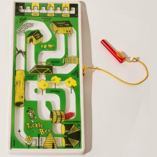
"Playtime's always fun
with Tickle Bee!"

"Something's always
bound to tickle me!"
I first heard the ad for the Tickle Bee game on the TV. I was about 8 at the time.
The next day, we went into the attic at my great grandfather's house on the farm.
He had a very old wind-up-phonograph with a magazine type record changer.
One of the 78 rpm records Dad put on it was "Ticklish Ruben" by Cal Stewart.
I said "Hey! That's the Tickle Bee song! On TV!" He didn't know what I meant.
The next day, the Tickle Bee ad came on again.
I said "This is the song I meant yesterday. The song on that record."
He still didn't seem to understand what I was talking about.
They were the same tune with different words (last lines of songs are at right).
I got a Tickle Bee game for Christmas that year.
When I was in my 20s, I bought a copy of that record I found in a garage sale.

I found black sap dripping from a tree during recess at school and used a stick to get a sample to look at.
Another kid was looking at it and got some on her clothes. That evening her mother called my father about it.
When my father asked me what it was (the girl said tar), I said it was sap.
My father said "Sap is not black!" He threatened to spank me if I didn't tell the truth.
I said repeatedly "Take me there and I will show you the tree." But he refused to believe it.
I had to lie and say it was something else to avoid being spanked.
I now know this gave wrong laundering information to remove the stain. But they wouldn't believe the truth.
I have since seen black sap coming from wild cherry trees with weather damage (right).
And alcohol removes sap.

I got as a gift a kit that made little 2-inch by 1-inch by 1-inch concrete blocks from real cement.
The kit contained:
- Instructions,
- A metal mold and two plastic hole pins to make one block,
- One sample concrete block,
- Enough cement to make two more blocks.
It took one whole day to make one concrete block and let it harden.
Then I realized it would be months before I had enough blocks to build anything.

I loved these Kenner building sets. My first was the Kenner Bridge and Turnpike set.
I had almost enough sets to build what is in this photo (from the cover of the project manual - right).
I used it to create interchanges of various types (note the cloverleaf in the left center of the photo).
I also had the Motorized Girder and Panel set, the Hydro-Dynamic set, and the Build a Home set.
I continued to use it from age 9 to age 16.
My intended profession was traffic engineering until I got my hands on a computer in my senior year in high school.
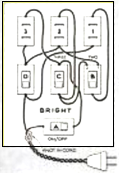
This circuit was published in the May 1961 Popular Science.
This switchboard could brighten and dim either two or three photoflood lamps.
It is SEPAR-302 in the booklet below
It is the shown circuit below.
This diagram is from the magazine.
I found a different circuit for two lights a few weeks later.
This sparked an interest in me for this kind of circuit. I started collecting and designing them.
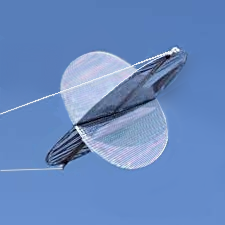
My father and I were coming home from a shopping trip in downtown Indianapolis.
As he drove north on the highway toward our house, we saw a brilliantly flashing object in the sky far in front of us.
It was apparently reflecting the sun and was flashing about 3 to 4 times a second.
We lost sight of it behind trees when we turned into our neighborhood.
Two days later, I got one for my birthday. It was a spinning kite similar to the one in this photo.
The flashing was the sun reflecting on the silvered surface of the horizontal member twice per rotation.
As shown in this photo, it spins clockwise.

I and my brothers were at home with a baby sitter while my parents were at some event. I was 10 years old.
I noticed as I was making cartoon drawings that the moon was changing. A full moon had become like a crescent.
I mentioned it to the baby sitter. She said I must be mistaken.
I did not get to see the rest of the eclipse because she said I had to go to bed on time.
I knew what an eclipse was, but did not know one was going to happen that day.
It was in the newspaper the next day.

But I didn't know this until 1996 when I analyzed his account of the sighting in his book.
I do remember that there was a story of his sighting in the paper two days after his sighting, but it had no details.
This story was the place I had first seen the term "UFO".
It was close enough to me that I found out what it really was.
The picture is my rendering of what I saw.
The yellow lights appeared at the right end of the arc, moved slowly to the left, and went out at the left end.
There were gaps between the lights at various intervals that moved with the lights.
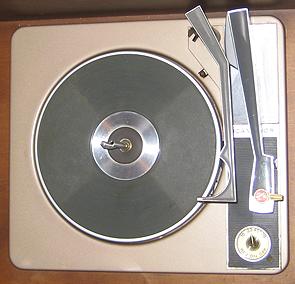
He said that both the RP-215 and the new RP-218 could play all standard record sizes (7-inch, 10-inch, and 12-inch) intermixed.
I showed him how the RP-215 cannot mix 7-inch records with other sizes because larger records hold down the 10-inch feeler.
I told him to put a 12-inch record on the turntable.
Then I asked, "Can the 10-inch feeler now tell whether a 10-inch or a 7-inch record drops next."
The 12-inch record covered the 10-inch feeler (black rubber tip next to turntable), so it had to select 10-inch.
This RP-215 changer can take 10-inch and 12-inch records intermixed, or play 7-inch records separately.
The RP-218 changer has a long falling record sensor and can take 7-inch, 10-inch, and 12-inch records intermixed.
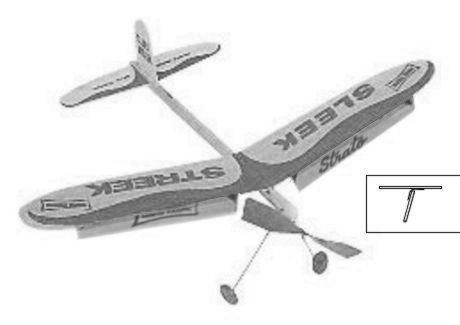
When I saw a vertical-takeoff airplane in a magazine, I had to try out the idea.
This airplane used huge wing flaps to redirect the propeller thrust downward to lift the plane straight up.
My Flying Model Simulating the Ryan Vertiplane
It worked better than I could imagine indoors. It jumped up into the air.
Outside, a strong wind could flip it over on takeoff.




In fall 1962, my art teacher gave each of us a 4-color watercolor set.
It had the old pigment primaries red, yellow, and blue, and a black for large uniform black areas.
She then assigned us to mix watercolors on little plastic palettes for a color wheel.
Then we were to paint patches of paint on paper for this color wheel.
Then we cut squares from these patches and put them on the color wheel and labeled it (right).
The problem was that the green looked black and the violet was almost black.
The art teacher blamed this problem on the cheapness of this paint compared to oil paint.
It is amazing that a new library book on the new color science was brought into our classroom that very week for reading.
I learned the new color theory from that library book.
This book had the primary colors for light (red, green, and blue).
It also had the new pigment primaries (magenta, yellow, and cyan).
Experimenting, I found that these new primaries worked much better than the old primaries.
I showed the book to the art teacher.
Two weeks later we got new paint boxes with magenta, yellow, cyan, and black.
We redid the experiment and got beautiful color wheels (right).
(The color wheels shown here are art software replicas, as I no longer have the originals. They were thrown out when my family moved.)
Note that oil colors work differently because they can change color with the thickness of the paint. Watercolors can't do that.
Question: 60 years later in 2022, why do I see art products, art classes, and children's books still teaching the obsolete primary colors?

I used a small benchtop vice I had for modelmaking to hold up the dip loop provided in the Easter egg dye kit.
The vice and dip loop held the egg in the dye cup so part of the egg was in the dye and part was not in the dye.
I dyed eggs like the ones shown at right with it.
I noticed that the dyes in the egg kit I used were the new pigment primaries and secondaries.
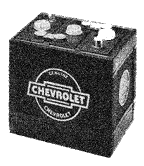
Dad got a new battery for the 57 Chevy and left the old one on the garage floor.
I was using it as a power source for my electrical circuits.
It was too heavy for me to move, so I used it where it was.
Dad read an auto tip: "Leaving a car battery on a concrete floor will ruin it."
He asked me if the battery still worked. I said that it did.
We found out why not to leave a car battery on a concrete floor when he moved it:
The surface of the floor was pitted under the battery, etched by battery acid that
seeped out.
Leaving a car battery on a concrete floor does not ruin the battery. It ruins the concrete floor.

I was at a Cub Scout meeting when I saw the record player the host family had.
This one used the pickup arm to scan the unplayed stack for record size from outside to inside.
It has a size control for playing a single record with the short spindle.
This played only the standard three sizes. It can't play a 6-inch record (above) automatically.

Animation example

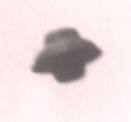

Umphant and Tri-umphant


Me:
When I was 5, I thought the deserts in Saudi Arabia were made of sawdust
instead of sand.
Me:
At age 10, I thought the Cover Girl brand meant that it was used to completely
hide the appearance of the girl.
Me:
When I was 7, my dad showed me how to draw cartoons. I asked how they
make cartoons come to life on TV.
He said, "They draw many pictures, with small movements in each. Then
they show all of them very fast."
"Our movie camera also takes many pictures very fast, and the projector
shows those pictures very fast."
Then he made a flip book animated cartoon on a small pad of paper. I made
some more flip books later.
I am still animating (right).
Me:
When I was 7, a classmate was telling about a TV show she saw, and said at one point:
"Then somebody put a hat on the telephone, and we thought it was a man."
I imagined a desk telephone with a hat on it, and couldn't see how it could look like a man.
Later I saw a rerun of the show. The hat was on a pay telephone in a phone booth.
From a distance, it looked like a man was in the phone booth.
My cousin:
I first saw a US road atlas at age 12 in my grandmother's house in 1963. I
couldn't put it down.
While I was thumbing through it, my dad kept asking me, "Where are you
going now?"
When I said, "I'm going to Massachusetts", my cousin (age 3) grabbed
a toy and ran to the kitchen crying.
His mother (my aunt) came into the room asking, "What did you say that
scared him so much?" I said I didn't know.
Then she said, "He ran in crying, saying you were going to mash his
choo-choo." I burst into laughter.
She said, "What's so funny about breaking his toy?" I held up the
atlas, "I said I was going to Massachusetts."
She said, "What are you talking about?" I said,
"Listen ... I said 'Mass-a-chu-setts' ... He heard 'Mash-a-choo-choo'."
We then explained to him that Massachusetts is the name of a state, like
Illinois is a state.
A few minutes later, my father asked the question again, and I said,
"I'm going to Philadelphia."
My cousin said, "I want to go to filthy dellthy!"
My brother:
We were watching cartoons on Saturday morning, That INS ad came on:
"If you are an alien living in the United States, you must report to the
Immigration and Naturalization Service
during January of each year."
My brother asked me how to tell aliens from regular people if they look like
regular people.
I said, "They are just regular people." Then he asked how to tell who
is from space and who isn't.
I said, "The people in that ad aren't space aliens. Those aliens are
people who came from other countries."
Then I mentioned some of our neighbors who were German citizens.
RELATED: In the 1970s, a Kentucky girl said she was from outer space. Her mother had told her she was an alien.
RELATED: I heard a kid in a restaurant say, "If he's a Vegan, then he came from Vega. Where is his spaceship?"
A friend:
I had a friend who thought that all of the monsters in the sci-fi movies were
real.
He said they had to be real or they couldn't film them. I told him about
special effects.
Another friend:
We were watching TV and a Welch's ad came on, with "juice made from
Concord grapes".
My friend asked, "Who conquered the grapes, and when? ... Wait!!! ... How
do you conquer grapes?"
Another friend:
We had just finished singing "O Come All Ye Faithful" in Sunday
school.
My friend asked, "What's an umphant? Is it some kind of elephant? ...
And why are there three of them?"
Could this image at right be the answer? Or is a triumph three umphs?"
(I once met a tuba player named Umphress.)
My brother:
He was telling about the nativity story and said, "Then these wise guys
came with gold, Frankenstein, and more."
A six-year-old neighbor girl:
My dad was in the carport cleaning the fish he had caught (cutting meat out
of each fish).
The girl walked up and asked, "What are you doing?"
"I'm cleaning fish. I cut the meat out of the fish and freeze it so we
can eat it later," he said.
She said, "Ewwww! I don't like that kind of fish! I like the square
kind!"
A relative:
My wife said, "Could you get me an ice water?"
He said, "Eye Swatter? Why would anyone want to swat an eye?"
Me:
"The restaurant servers are called waiters because they produce
wait."
My father:
We got a new kind of fruit punch.
He took a drink and said "This tastes pink!"
My brother:
My brother yelled from the bathroom, "Mom! The hole in the bottom of
the toilet is gone!"
I hurried to the bathroom to look.
Mom had put toilet cleaner (a white liquid) in the toilet bowl. This liquid
hid the hole.
My brother:
We were choosing positions for a softball game in the back yard.
My brother said "I wanna be first basement!"

We were at my grandmother's house. I was expecting this one and was ready for it.
I had built a sunscope for the occasion. This was a box with a pinhole at one end and a white screen at the other.
You put it over your head and faced the screen, with the pinhole over your head pointed at the sun.
DANGER: NEVER look at the sun through binoculars or a telescope. It will destroy your vision.
I got to see the entire eclipse. It was total in Maine, but I was in Illinois that day.
The diagram shown is part of one in that was the paper that morning.
I kept looking for total solar eclipses close to where I lived for years. There weren't any until 2017.


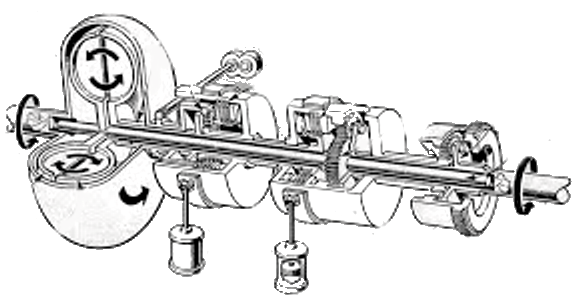
I used Tinkertoys™, rubber bands, and wood parts I made myself to build a working model of the Hydramatic gears.
The Hydramatic (and most other) automatic transmissions use planetary gears.
Planetary gears have sun gears, ring gears, planet gears, and planet carriers.
The parts I made are planet carriers (violet) and ring gears (green). Only one of the 3 gearsets I made (the middle one) is shown.
(The parts were not really colored green and violet. I used the colors here to illustrate which parts are which).
The planet carrier (violet) takes a shaft and shortest rods to hold two pulleys on opposite sides of a Tinkertoy spool.
The ring (green) has a hole that just accepts a spool and two pulleys across its diameter (inset and in cross section).
The ring is a square with the large hole in the middle and holes for four rods in the corners (two are shown).
I put rubber bands (brown) on the pulleys to simulate gear teeth. They also had friction to act as the direct clutches.
I used rods that could be moved in to stop certain parts to act as brake bands (yellow at bottom).
I used rod bearings, rods, and a wood base to hold up the shafts (not shown).
Since I had no way to simulate the hydraulic coupling, I left it out. The model shows only how the gears change.
In the gearset shown, the power comes in on the red shaft and turns the sun gear (spool).
The planet carrier turns the blue shaft to send the power on.
In reduction mode, the ring is stopped. The planets (pulleys) roll around the sun to turn the planet carrier at a slower speed.
In direct mode, the planet carrier and ring turn together (the rubber bands drag it) so everything turns at the same speed.
A diagram of the real Hydra-Matic is shown at right. That is the same diagram I used to make the model.
In the real transmission (right), disc clutches were used to couple the ring to the sun to turn them at the same speed.

To make play easier, we set the mower lower and mowed paths for the croquet balls to follow.
We did this so grass would not deflect the balls.
Originally, we just mowed the double diamond shape.
Later we added the extra paths to make play easier and make location of the paths easier to calculate.

I was (and am) 6 years older than my oldest brother.
My brothers kept messing with my stuff while I was at school, often breaking things.
When we lived in Indianapolis, I had a key for my bedroom door so my brothers could not get in there.
When we moved back to Bloomington, my room had a sliding door with no lock.
One of my brothers broke my radiometer, so I needed a way to protect my things.
I tied a suitcase tag to a small bell and several sleigh bells, ending with a long string.
I tied the other end of the string to one end of the door lintel.
To set the alarm, I stood on the outside of the door and shut the tag in the door up high.
If the door opened while I was at school, the bells would fall and ring as they banged on the doorframe. This called my mother.
My brothers were not tall enough to reset the alarm.
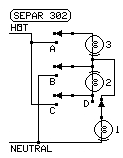
I had become interested in several different published ways I had found (and a few more
that I had devised)
to make switchboards that select between series and parallel operation of lamps.
I compiled these into a booklet in 1965.
These circuits are on the web page Simple Series and Parallel
The booklet contained all of these circuits that are on the web page:
SEPAR-201, SEPAR-202,
SEPAR-300, SEPAR-301, SEPAR-302, SEPAR-303, SEPAR-305, SEPAR-330,
SEPAR-400, SEPAR-401, and SEPAR-402A.
The identifying numbers for these circuits are mine. I coined them for the booklet. SEPAR-302 is shown.
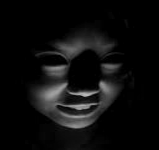
It was Halloween and all of us were given new flashlights for safety on the street.
After trick-or-treat, we were in the front entryway of the house.
There is a large mirror on the wall opposite the front door.
The lights were out and we came in with our flashlights on.
Someone asked where I was, and I pointed my flashlight up at my chin.
The flashlight on my face from below momentarily scared one of my brothers.
Then we all started doing it while looking in that mirror and laughing,
Only many years later did we find out that the Scary Flashlight Face was a gag used in silent movies.

I found a mysterious message on the counter where we often left notes for each other. It said:
Happy
Todel
Niddles
The Big Baby
I wondered who the note was about and why it was there.
At supper, I said, "What is that note on the counter, what does it mean, and who is Todel Niddles?"
My brother (in 2nd grade) said, "That fell out of my folder. Those are the animals
in the book we read in school today.
Happy is the dog. Toddle is the turtle. Nibbles is the rabbit, and The Big Baby is
the elephant.
I said, "But it says 'Niddles'."
He said, "Oh no! I got my 'b's backwards again."

I was a member of the flying club when I was in junior high.
The teacher and some of the guys made a balsa and silkspan flying saucer with a ducted fan model airplane engine.
The image at right is a rough sketch of it.
They picked a calm day to try flying it. There were no flight controls.
It rose and hovered for a few seconds, with the disc spinning the opposite direction to
the rotation of the propeller.
Then it tipped sideways, fell to the football field, and rolled away off the field.
It rolled off the school grounds and disappeared from sight.
They found it two blocks away in a ditch.
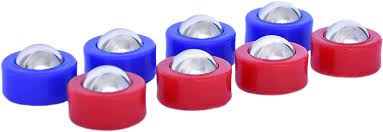
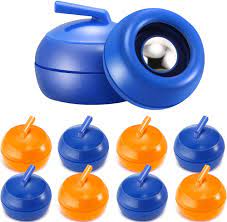
I was playing with some 1/2-inch steel ball bearings I got in a parts package.
I had some 9/16-inch cardboard sleeves and slipped them over the bearings.
I got a neat little toy where the ball rolls on the floor or a table inside the
sleeve, which slides on the surface.
Then I made a little cone top for one of the sleeves with a fin on it. The sleeve
turned so the fin was always behind the ball.
My father suggested that I should develop it and patent it.
The next day I found in the toy section of the grocery store the thing
I invented.
These "Scoots" were little plastic cones with holes in the flat bottoms
where the bearings stick out.
They worked just like mine.
I couldn't find pictures of these on the Internet, but I found pictures of the similar
objects.
The shuffleboard pucks and the curling stones pictured are the same thing.
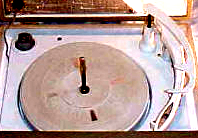
I was in a record store and wanted to hear a 45 rpm record to make sure it was the right one.
The salesman put it on a Magnavox player similar to the one shown.
I was amazed at how the pickup arm tip measured the record stack for exact size from outside to inside.
It was even more interesting how it felt for a record size, didn't find a record, and shut itself off.
I immediately realized that this changer requires a pyramid stack of records (larger below smaller).
Many of these can play that 6-inch record (above) automatically.
This was the day I became quite interested in record changers.
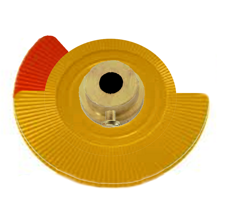

I built the 3-way signal head for a Tee intersection with a green left-turn arrow for the turn into the stem of the tee.
I made a frame for a 1 rpm motor with a long shaft and for a set of microswitches mounted on the frame.
I designed cams using poker chips, intending to by glue bushings to the centers of the chips. The cams would have changed the signals.
Microswitches would feel cam edges. Two identical cams (yellow and red shown) put back-to-back can adjust the width of the active slot.
Two microswitches would work each set of signals. One chooses red when inactive. When it is active, the other chooses green or yellow.
The movements with the green left-turn arrow on are shown.
I didn't finish this. I used the motor to make a color filter wheel instead.
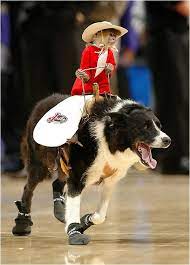
Here are a few of them:
- "There's no news like a dead horse."
- "Always dry your feet before kicking a harp."
- "If it weren't for Illinois and Ohio, Indiana would cave in."
- "Who put termites in the Lincoln Logs?"
- "There goes Mickey Rooney riding into the sunset on a police dog."
- "Goofy is the only guy I know of who can fall up the stairs."
- "Want to have a peanut butter fight?"
- "They aren't gooderies, they are badderies. They're dead."
- "If I had a hammer, I'd probably hit my thumb."
- "If you won't smile, then snile."
- "We are going to clown brownty."
- "Visualize an octopus playing the drums."
- "Which end of that dog is the head?"
- "I tiddled my lids" (After mother put the mayonnaise lid on the salad dressing and dropped the salad dressing lid in the mayonnaise).
- "Isn't that down by the stove dump?" (a place where many kitchen stoves were abandoned).
- "Ferryboat Godfather" (my father with his pop-up stern light for his boat - looks like a magic wand).
- "Twilight Toads" (My father reassembled the steel frames for kitchen chairs with the seats upside down to paint them. They looked like giant toads.)
- "Tree Kit" (My father cut up a fallen tree into firewood-sized pieces, leaving them where they fell. He called it a "tree kit".)
- "Hide the donuts before Old Fishfingers gets into them."
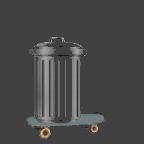
People would hear loud rumblings in the dark at our house on Sunday evenings.
I had discovered that I could put a trash can on the front of my skateboard, get on the back end and ride it.
I rode the cans down the sloped driveway to the street to be collected the next morning. I made one run for each can.
The next day I rode the board down, put an empty can on, got on behind, and pushed with one foot to ride it up to the carport.
I also used the skateboard to move baskets full of raked leaves.

I found a way to light up a small neon sign with a 6-volt battery.
All you need are the battery, a switch, a relay, a capacitor, an auto spark coil, and the neon tube.
I tried different capacitors and chose the size that gave the best result.
I also used this circuit and a larger capacitor to make a strobe light with a small fluorescent bulb.
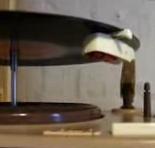
I was at a Christmas party, and this record changer was playing records.
I noticed that the arm was not swinging out all the way between 45s.
The teen who was running it said, "That's how it checks the size."
This was like a Collaro (above), only the scan was from inside to outside.
It scans the underside of the stack looking for record edges.
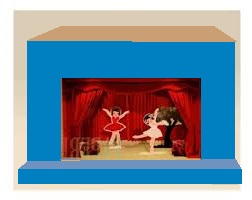
The stage had beam lights, border lights, footlights, tormentor lights, and upper and lower cyclorama lights.
The control board had repatchable dimmers, so a light fully up could be removed from the dimmer.
A master dimmer could dim all of the lights.
Pushbuttons could be patched to lights for flashing (e.g. lightning) effects.
The patch panel was on the back of the cyclorama and provided full patching with screw terminal strips.
Spotlights were created by using #222 lensed lightbulbs.


I added antiskate, single-play repeat for all record sizes, full manual operation, and a stop command.
Because the arm is an underhang arm, the antiskate works backward to normal antiskate.
It repeats one record on the turntable over and over if the overarm tip is placed over the record rim (blue numbers).
(A lever I put on the overarm shaft moves the 12-inch drop feeler when the overarm moves toward the rest post.)
Hold the control in REJ until the arm stops swinging out to make the changer shut off now.
(A link I put on the reject control activates the auto-shutoff lever as though the overarm activates it by being low.)
(This link is active only when the control is in the REJ position.
To return the arm to rest without turning off power, hold the control in the REJ position until the arm sets down.
For full manual operation:
- Place the record on the turntable
- Set the speed to N
- Select ON - Turntable will not turn
- Move arm in as far as it goes, then back to the rest post
- Rotate the turntable backward at least two turns
- Select the speed - Turntable will rotate
- Place the arm where desired
- Changer will not trip at the end of the record.
To return to automatic operation, use REJ
(To add full manual, I cut off the position trip boss on the velocity trip pawl.)
| FEATURE | WHERE THE FEELER IS | |||||||
|---|---|---|---|---|---|---|---|---|
| SIZE KNOB |
TURN- TABLE |
DISC DROP |
STACK FEEL |
DISC ALONE |
TABLE TOP |
TONE ARM |
SIZE SAVE |
|
| Random size intermix | no | no | YES | no | YES | YES | OK | − |
| Arranged mix (large 1st) | no | no | no | YES | no | no | OK | − |
| No size intermix | YES | YES | no | no | no | no | OK | − |
| Odd sized records | no | no | no | OK | OK | OK | REQ | − |
| Repeat a record control | YES | YES | Pt1 | Pt1 | Pt1 | YES | OK | Pt2 |
| Repeater disc in stack | YES | YES | no | Nx= | no | YES | OK | − |
| Random Speed intermix † | no | no | YES | no | YES | YES | OK | OK |
| Arranged Speed intermix † | no | no | no | YES | no | no | OK | no |
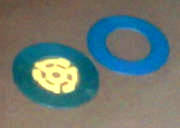
Repeater discs
|

Dual 1004 buttons
|
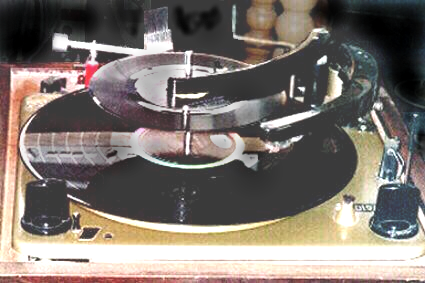
Collaro TSC-640 |
- As I repaired various record changers, I noticed how various devices behave.
- SIZE KNOB - Manual control of record size
- TURNTABLE - Feelers in the turntable
- DISC DROP - Record is felt while it drops
- STACK FEEL - Unplayed stack size is felt
- DISC ALONE - Feels record while separated from others
- TABLE TOP - Feels only top record on turntable
- TONE ARM - The feeler must be in the pickup arm
- SIZE SAVE - Size is remembered or set by repeat control
- no - Does not work
- OK - Can work
- YES - Works alone
- REQ - Required
- Pt1 - Requires a Pt2 to work
- Pt2 - Requires a Pt1 to work
- Nx= - Next record must be same size
- − - Does not apply
- † - Requires speed intermix device
I also discovered just how hard it is to make a record changer with all of the following features:
- plays odd sizes
- plays randomly intermixed sizes
- repeats any record in the stack
- plays a single record already on the turntable
- doesn't touch the grooved surface of the record
Dual 1003, 1004, 1005, and 1006 do the first 4 at the expense of touching the record surface.
Collaro TSC-640 (right) does 1, 3, and 5, and plays arranged intermix (larger records before smaller).
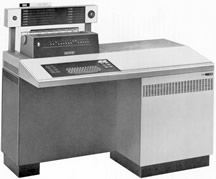
My original choice was traffic engineering (part of civil engineering).
Then I got hands-on experience with computers. I used a CDC 3600 and an IBM 1130.
The photo shows an IBM 1130 that had 4 K of memory. The memory module was the size of a refrigerator and is not shown.
I totally changed what I wanted to do. I now wanted to program and work with computers.
In my working life, I programmed computers, built computer and laboratory equipment, and taught computing and math.
I still occasionally had something to do with traffic engineering.

A magazine about UFOs had a project for building a UFO detector.
It is essentially a magnetic field detector. If the compass needle deflects, the bell rings.
I built one, and was actually more interested in it for protecting my music tapes
(Magnetic fields can erase tapes and computer discs).
It detected everything except a UFO.


A pie plate or cake pan of clear water is placed on the stage of an overhead projector.
My filter device (inset) is placed in front of the objective lens so the light goes through it.
The projector is aimed at a screen or whatever the light is to be played upon.
Agitate the water in the plate by shaking the plate. Colors appear on the screen.
Squirt water in the plate with a squirt bottle or eyedropper.
Put an Alka-Seltzer in and let it fizz.
Sloped surfaces from ripples bend the light to pass through only part of my filter device.
I later found a way to make a similar effect without water, using two clear plastic corrugated produce trays.

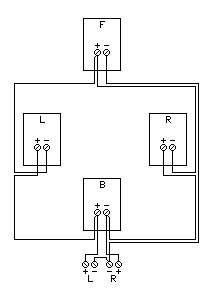
Quadraphonic Mixing - 1971 Stage Play
I used the Dynaco Diamond (DD) system.
This could possibly be the very first creation of such matrix quadraphonic effects for a stage play.
The mixing was actually done in late 1970, with a few edits in 1971.
I also built the decoder for the auditorium (right).
It required only one stereo amplifier and a stereo tape recorder.
The sound effects and voices were quite effective.
My encoding method would later become how I encode surround sound with standard mixers (way below).
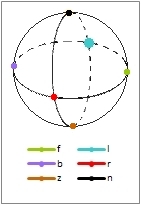
|

|
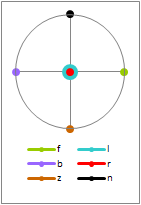
|
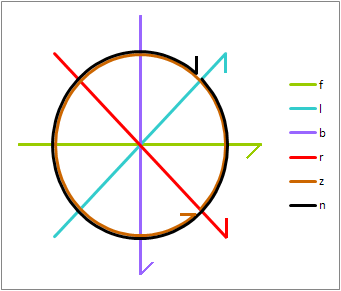
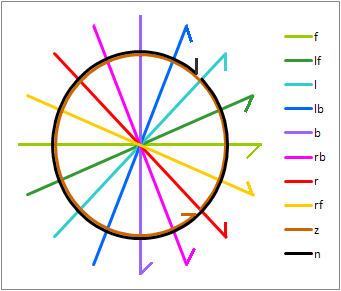
|
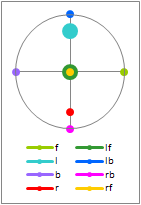
|
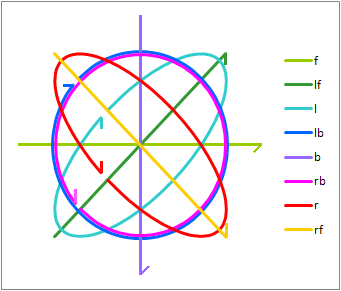
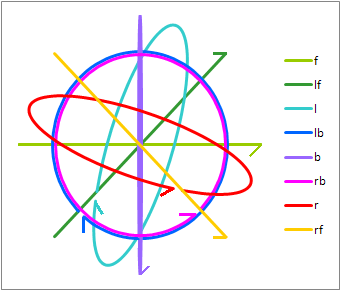
|
- Henri Poincaré devised this sphere to plot all possible relationships in polarized light.
Léon Foucault used the sphere to plot all possible swinging paths of a pendulum on a rope.
I learned about the Poincaré sphere in physics class.
The Poincaré Sphere showing phase relations and phono stylus motions is in the diagrams at right,
The following are the six orthogonal modulations defining the Poincaré sphere.
- All modulations are on the surface of the sphere.
- The colors in this list apply to only the upper two rows of diagrams.
- Points on the far side of the sphere have large dots here.
- Points on the near side or the limb have small dots here.
- Horizontal (in-phase or mono) is at the right of the sphere (olive);
- Vertical (180° phase) is at the left (violet).
- The left-channel diagonal (cyan) is centered on the sphere's far side.
- The right-channel diagonal (red) is centered on the sphere's near side.
- Clockwise motion (90° L>R) is at the top of the sphere (black).
- Anticlockwise motion (90° R>L) is at the bottom of the sphere (brown).
Top Row: Left diagram is an oblique projection of the sphere.
Top Row: Right diagram is an isometric projection of the sphere.
Middle Row: Left diagram is a projection of the sphere from the right channel side viewpoint.
Middle Row: Upper right image shows the stylus motions in the record groove for each orthogonal signal.
The spheres and stylus diagram listed above also show the Dolby Surround matrix system.
The Dynaco Diamond matrix also has the same Poincaré sphere that Dolby Surround has.
Any quadraphonic matrix system encoded to records or other 2-channel media fits on the Poincaré sphere.
The colors shown in the diagrams listed below do not correspond to the colors in the list above.
The colors for positions below are red = R, olive = F, cyan = L, and violet = B.
The added colors for below are yellow = RF, green = LF, blue = LB, and magenta = RB.
Middle Row: Lower right image shows the record groove stylus motions for Regular Matrix signals (e.g. Sansui QS).
Bottom Row: Left diagram is a right-side projection of the sphere showing the Columbia SQ matrix.
Bottom Row: Upper right image shows the stylus motions in the record groove for the SQ matrix.
Bottom Row: Lower right image shows the stylus motions in the record groove for 4-corners SQ encoder.
(Right click any image and choose 'View Image" for a bigger version.)
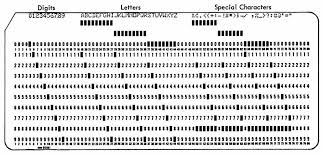
I had an idea to use the bit patterns in either punch cards or ASCII for encoding.
ENCODING:
I made a table of the 26 capital letters in the English language.
I used a keyword to make two lists of 13 letters each.
For each character in the original message, do the following:
Separate the 7 bits in the character code (in ASCII) into individual bits.
For each bit, select one capital letter from the lists.
If the bit is a 0, randomly choose a letter from the first list
If the bit is a 1, randomly choose a letter from the second list
Add the new letter to the cyphertext output.
Save the cyphertext output as a file and send it.
DECODING
Use the keyword to make the same two lists of 13 letters.
For each group of 7 letters in the cyphertext:
For each letter in the group:
Find which list the letter is in.
Make a 0 or a 1 depending on which list the letter is in.
Combine the 7 bits into an ASCII coded character.
Add the new character to the plaintext output.
Save the plaintext output as a file and read it.
The special knowledge is knowing that this system was used. If so, breaking the keyword is not too hard.


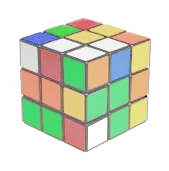

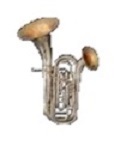
The spoonerism, the unintended transposing of parts of words in speech, was named
after Rev. William Archibald Spooner
(1844 - 1930), an Oxford don who was known for making these mix-ups.
Here are a few I heard. Figure out what was intended:
- "I don't like spussel brouts."
- "I want ched spree on my toast."
- "Tell Bellophone"
- "Birty dirds"
- "Milled spilk"
- "The Stoo Threeges"
- "You need a little pix of pinchie dust."
- "He played a phylozone" (right)
- "Swee Preetened Kool-Aid"
- "Haxwell Mouse Coffee"
- "I'm cocoa for Cuckoo Puffs."
- "A teaping heaspoon"
- "So they passed the Haft-Tartley Act."
- "Here's the whyson ree - er - risin' whee - uh - wheezon rye."
- "Eat sooten ferds for needed minerals."
- "Contact your offected eelicials"
- "Peaner butnut jar"
- "Unitary Miliforms"
- "Listen! Burping chirds"
- "Biologists use the breast of inbed rabbits to keep all else equal."
- "They have a hest ghost this week."
- "Puhsh huppies"
- "All the kill and scare you expect in our pharmacy"
- "What if they use an abombic tom"
- "Assified Clads"
- "Populotion Explasion"
- "Let the smoke out! I just churned the bees!" (right)
- "Pelfare wayments"
- "A cycrotlon is a satom masher."
- "They filed a sawloot."
- "It's a Cubic Rube" (right)
- "Diberal Lemocrats"
- "Those solid rooket bosters will take the shuttle up to the upper atmosphere;"
- "This is the Indianapolis Spotor Meedway Network"
- "Harbokydrates"
- "Colly-potten pants"
- "The Rome of the Dock" (right)
- "A jar of nixed muts"
- "Poodio astartment"
- "Don't use Spacebook or My Face during the test."
- "Errors in the Surality Voting Plystem"
- "It's like tubing squeezepaste from the tooth."
- "Pikiweedia"
- "Look! I bee a double-hued cellphonium!" (right)
- "Ower poutage"
- "The Muntry Cusic awards"
- "A stelve-twep program"
- "Bottlebats is on tonight."
- "Tester Siresa worked in Calcutta."
- "Have a botter watle."
- "Fraint Sancis the sissy"
I heard this one twice myself, and the original Rev. Spooner said it too:
- "Kinquering congs"
And a special section for Meatherwen:
- "Expect shattered scunder thowers."
- "Tomorrow will be clouder and warmy."
- "Outside right now we have drain and rizzle."
- "Tonight, mixed sneet and slow."
- "A thumble of runder in Spencer."
- "We will have skunny sies today."
- "It twenty snine degrees at noon o'clock ... uh ... twelve o'noon."
- "So you treat the sandy road with this salt and snow mixture."
- "It's too clousy to dee the eclipse."
- "Rain Wednesday, which has a 20% chance of being followed by Thursday. Frynee will be Sunday."
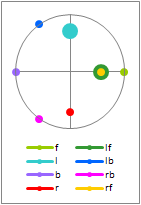
|

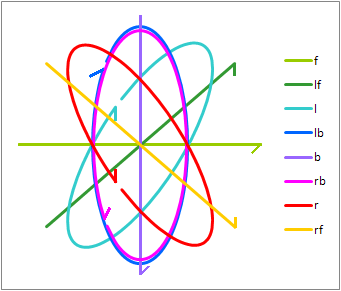
|
- I used Henri Poincaré's sphere to derive a max separation quadraphonic matrix.
My purpose was a matrix with equal separations between any channel and the other three channels.
I achieved a separation of 4.8 dB (QS has a 3 dB adjacent separation and infinite diagonal separation).
The colors for positions below are red = R, olive = F, cyan = L, and violet = B.
The added colors for below are yellow = RF, green = LF, blue = LB, and magenta = RB.
The left diagram is a right-side projection of the sphere showing my UQ matrix.
The upper right image shows the stylus motions in the record groove for the UQ matrix.
Columbia said to use a 10% front blend and a 40% back blend if no separation enhancement is used.
The lower right image shows the stylus motions in the record groove for this similar blended SQ decoder.
Later I found out that Peter Scheiber had made these calculations before me.
(Right click any image and choose 'View Image" for a bigger version.)


It was easy to build a fully adjustable passive Regular Matrix quadraphonic decoder.
(Right click the image and choose 'View Image" for bigger version.)
Only a two-channel stereo amplifier is needed.
I used a design similar to the back speakers of Dynaquad except for the DEPTH control.
I used a simple blending circuit for the front speakers using the WIDTH control.
This is placed between the output of the two-channel power amplifier and the speakers.
This can be adjusted to decode any of the Regular Matrix systems.
It can play QS, EV, DQ, DD, and Dolby Surround.
The parts were easily available at the time. But now the rheostats have become scarce.
I make the new versions with 8-ohm L-pads because I can get them.
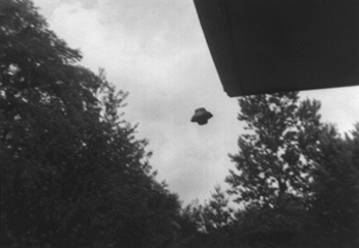
We had a huge wave of UFO sightings in my area in 1973.
I decided to take some equipment out and try to find out what people were seeing.
I found a high point in the city and watched in all directions for anything people might see.
I saw only Mars (extremely bright in the eastern horizon) and two airplanes. No UFOs.
The newspaper said that others saw UFOs that were apparently directly over my observing site.
I deduced that the witnesses could have observed two kinds of events:
- Objects that were lower and closer to the witnesses (so I could not see them)
- The planet Mars millions of miles away and low in the eastern sky
The first case was confirmed when police found the remains of fire balloons near the area where the sightings occurred.
I took the photo at right by hanging a model I made from the roof above it.
I hung it with monofilament fishing line to test if the line could be detected in
the negative. It was not.

I was turning left and my signal turned yellow, then red. I was in the intersection and waited for oncoming traffic to stop.
What I didn't know was that the oncoming signal remained green. The line did not stop. This is yellow trap.
I saw that this was a hazard and wrote the state highway department about it.
They wrote back and said they made a device for that signal to prevent the hazard.
But it didn't work. I still saw yellow-trap events at that signal.
I called it "lag-trap" at the time because it happens with lagging left turn phases.
DANGER: NEVER assume that oncoming traffic has the same color signal that you have.

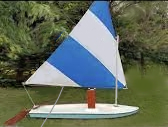
I had previously read about sailing. A basic sailboat has three control surfaces:
- The keel or centerboard, the rudder, and the sail.
- They act together to propel and control the boat.
We went to a cabin on a lake for vacation (mostly so my father could fish).
We found a little sailboat on the back porch. We received permission to use it, and I tried it out.
Within a week, I had fully learned to operate it and was whizzing back and forth across the lake.
I built a device that clips onto the centerboard and indicates both wind and compass direction.
The wide end of the wind vane stuck up 2 inches above the dials so the wind moved it.
We went back to that same cabin two more years.
The second year we found out the owner had died. The heir sold me the sailboat.
I had the sailboat for 20 years (right). I finally sold it because I had no vehicle that could transport it.
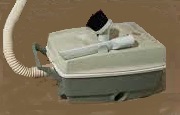
We had our cat Tammy for 17.5 years.
For years Tammy always ran away from the vacuum cleaner because it made noise.
One day, Tammy was asleep in the corner by the coat closet door in the hall.
Mom was vacuuming in the living room, and then pulled the vacuum cleaner near the hall.
She had taken the attachments off, so just the end of the hose was being used to pick up
dust from the baseboard.
Tammy was boxed in by Mom and the hose, and she decided not to move.
On impulse, Mom reached over and vacuumed all of the shed hair off of the side of the cat that was up.
Tammy loved it. She stood up and let Mom vacuum all of her fur. It felt good.
From then on, Tammy came running when she heard the vacuum cleaner, because she wanted to be vacuumed again!

I added a magnetic cartridge, antiskate, cueing, arm range, size range, turntable stop, and autospeed.
This is closer to a record changer that always gets the size right (see above), but not quite.
It always gets the size right if the records are stacked in pyramid order.
Pyramid order is arranged intermix (larger records below smaller records).
Turntable stop stops the turntable during the change cycle so the records don't slide on each other.
Autospeed also lets it play a stack with large 33s followed by small 45s (as shown).
(The brass feeler arm near the overarm shaft works Autospeed for arranged intermix.)
Repeater discs (above) work in a stack if the records above and below a repeater are the same size.
Yes, it can automatically play that 6-inch record (above). The arm feels the exact size (as in photo).
The cue control I added is at the right edge of the photo just behind the automatic knob.
I replaced the sleeve bearing on the arm shaft with a ball bearing, and added antiskating.
I installed a Shure magnetic cartridge in place of the ceramic cartridge that came with it.
The amazing part is that the Collaro trip mechanism works at the new low tracking force of 2 grams without any modifications.
I modified this changer because nobody ever made a changer with all of these capabilities.

I was sailing my boat (see above) on Monroe Reservoir when I saw a very bright light to my right (west).
The light seemed to be like a star in size, but it was as bright as the sun (which was near the object in the sky).
Other boat traffic appeared from under a bridge and I turned my head to look for possible collision paths.
When I looked back, the object was gone.
Remember that UFO is the acronym for Unidentified Flying Object. It does not mean aliens.
I am sure the sun was reflecting from some object in the sky. It is unidentified only because I don't know what was really there.
This picture is an artist's conception.

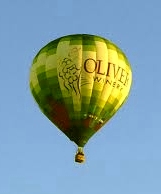
One day we were having lunch at our house when our dog Penny started barking, and then howling, straight up.
Then a loud ROAR! I ran outside. A hot air balloon passed very low over the house (actual balloon in right photo).
I heard the pilots remarking about the croquet paths we had mowed in the grass (item above).
I learned two things: How big the balloon really is, and how loud it can be.
My title for this entry comes from a line from the TV show F Troop.
(This is the likely solution to the 04/24/1964 Socorro NM UFO Sighting - inset.)
(Inset balloon is an artist's rendering.)

I modified the fully adjustable passive Regular Matrix decoder.
(Right click the image and choose 'View Image" for a bigger version.)
This is still placed between the two-channel power amplifier output and the speakers.
I added the Autovary function to narrow the back separation with heavy front center sounds.
The lightbulb increases its resistance by 8 to 10 times when hot.
When the lightbulb is cold, the separation between the LB and RB channels is wide.
When the lightbulb is hot, the separation between the LB and RB channels is narrow.
When the lightbulb is cold, the separation between FC and the back channels is low.
When the lightbulb is hot, the separation between FC and the back channels is high.
This can still be adjusted to decode any of the Regular Matrix systems.
It can still play QS, EV, DQ, DD, and Dolby Surround.
To turn off Autovary, set the Autovary control to minimum resistance.
Adjust Autovary to produce a just noticeable change in back separation with front sounds.

I had been trying to get the dog (Penny) and the cat (Tammy) to be friends.
The dog wanted to be friends, but the cat would have nothing to do with
the dog.
Usually when we went on trips, we left the dog and cat outside and arranged for the neighbors to feed them.
Whenever we returned from our trip (a few days to a week), both the cat and the dog came running to greet us.
When we returned from one trip, we wondered, because neither the cat nor the dog came running to us.
I was afraid that something had happened to them. I went to the side of the carport where the dog stayed on a runner chain.
I was totally surprised to see both of them asleep in the grass, lying back to back.
From then on, we had a cat and dog team. When one indicated something wrong, the other came running.
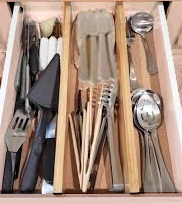
When I do April Fool pranks, I never do anything that can damage or ruin anything.
I was a college student that year, so I didn't have time to do anything elaborate.
For a prank on my mother, I took three of the kitchen cabinet drawers out and put them in the wrong cabinets.
For a prank on my brother, I put a card saying "April Fool" on his guitar, but did nothing else.
Just before I had to leave for class, mom came into the kitchen and discovered the drawers in the wrong places.
When I got home, I found mom putting the contents of one of the drawers in a box to move them.
She said she didn't understand how I was able to move the drawer contents so quickly.
I then realized that she didn't know that the drawers could be taken out of the cabinets. I said, "I took the drawers out."
Then I showed her the button you push to unlock a drawer (black, at left back of drawer image).
Then I quickly took the drawers out and put them back in the places where they belonged.
I had to go to class again. When I got home, I found my brother had been frantically searching for what I did to the guitar.
He said "What did you do to my guitar?"
I said "I just put a sign on it. You played the rest of the prank on yourself looking for what I didn't do."

The last assignment in my digital logic and microprocessors class was to do something linking the computer to the real world.
Of the many suggestions in the assignment was to use the computer to play music.
The text suggested using an output port to feed a digital-to-analog converter, which then runs a voltage-controlled oscillator.
After experimenting with these devices, I found that the 8-bit D-to-A converter lacked the resolution for tuned music notes.
Several others experimented with this and got awful out-of-tune tones. I decided another method must be used.
One day I hooked up my circuit, put in my program, and started the computer.
Out of the speaker came the theme to Star Wars in single notes (no chords) in perfect tune.
I used the D-A converter to set the volume for each note, and used loops in the program to generate the pitch.
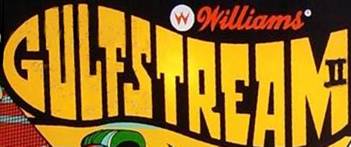
I put myself through college fixing pinball machines and video games for an arcade company.
The design was also another product from that digital logic course (above).
I turned a machine that brought in 75 cents a day into the third highest paying machine.
It had two eject holes that just kicked the ball back.
My modification made it keep the first ball that went in and give a free ball at the shooter.
When both balls were in the holes, they both ejected at the same time.
This page shows how it was done: Double Ball Gulfstream II

I designed and built paper airplanes with a low sink ratio.
This plane looked a lot like the bottom plane on the book cover. I no longer have these
planes.
Two of them were in unusual events:
- One was entered in a paper airplane contest.
We threw planes from a second story staircase landing and measured the flight time.
My plane flew for 20.9 seconds. - Organist Dennis James recreated the experience of watching a silent movie of the 1920s.
He played an organ score provided by the film company.
Many of the patrons attending the event threw paper airplanes around in the Indiana University Auditorium.
The front of the balcony is 118 feet from the stage.I threw my airplane of this design from the front of the balcony.
My intent was to land a plane thrown from the balcony on the stage.
I did this but not in the way I intended:I threw the plane and it headed for the stage.
But halfway there, it was caught in the updraft of the huge HVAC intake register and fan on the ceiling.
The plane went up, and then began doing loop the loops in that airstream.
It continued doing that for over 5 minutes.
Then the fan turned off and the plane started gliding again and it did land on the stage.
I also made a flying model of the B-1 swing-wing using punch cards, glue, and paper fasteners.


I added the blue REPET position to the command lever (shown).
This position causes the already playing record to play again after it finishes.
I added the ability to use repeater discs in the stack (shown).
Placing a repeater disc in the stack causes the record under it to play twice.
Otherwise the changer behaves as though these changes were not there.
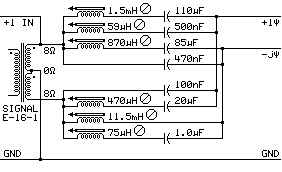
It is easy to build a passive Regular Matrix decoder. I wanted to see if a passive SQ decoder could be done.
(Right-click the image and choose 'View Image" for bigger version.)
This is a quadraphonic decoder that goes after a 2-channel power amplifier.
I had lucked out at an auction and won several large cartons filled with electronic parts at a very low cost.
In those cartons were two large transformers with dual 8-ohm windings. I used them for the ψ (psi) phasors.
Also among those parts in the cartons were all of the inductors in these circuits.
I used an oscilloscope to tune the 8-pole ψ phasors for 90° from 15 Hz to 20 KHz (right).
A switch selects between no phase shift, 90° phase shift, and SQ decode mix.
The rest of the decoder is basically the UQ-1 decoder (above).
Push Imed 0001
Pull Intd 0004
From Imed 0001
Forl Intd 0003
Step Imed 0001
Till Intd 0002
Push Intd 0004
×
Push Intd 0003
=
Pull Intd 0004
Next Intd 0003
I had an idea on how to make a computer with machine code that can be read as a text file.
Each of the operation codes for the computer spelled a word or abbreviation with 4 ASCII characters.
Executing any code that did not spell something the CPU knew would have made the computer end the program.
Symbols surrounded by spaces would have been mathematical operators.
Data references would have been hexadecimal numbers relative to the data area.
This could have made computer bugs and viruses easy to spot. This picture shows how the text would have read.
I actually bought some materials to make this, but the pressures of life in this world kept me from making it.
Once the computer world had centered all efforts on Intel and Motorola microprocessors, this idea became moot.
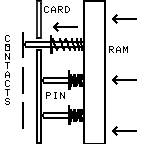
Documation
card reader
While I was in college and afterwards, I repaired all kinds of computers and peripherals:
- In a class on computer structures, we built replicas of the Digital Equipment
Corporation PDP-8.
At a job a few years later, I had the need to repair a PDP-8.
I knew exactly what to do and made repairs inside the CPU. - We had several Documation card readers around the department.
One of my duties was to test the readers once a month to see if they needed cleaning.
This test required running a deck of 30 cards through the reader 30 times, then looking for dimples on the cards.
A dimple indicated a cleaning was needed (more on this below). - I repaired many Teletype 33 keyboard printers.
A few years later, I won a disassembled Teletype 33 and a manual in an auction.
I reassembled it (all the parts were there!) and got my first printer.

When I graduated from college, I went through the line and got a diploma.
When I got it home I looked at it.
Instead of my Bachelor of Arts in Computer Science, I got a diploma for a Bachelor of Arts in Physical Education.
Someone with the same name as mine got a BA in PE, but didn't go to commencement. So they gave me his diploma.
So would I have to teach computers to play sports (right)?
No! A trip to the Registrar's office the next day straightened it out.
But it was prophetic. I later became the lab engineer for the Kinesiology (Physical Education) department for 13 years.

OTHER

OTHER

I almost died due to an exposure to latex rubber in interior wall paint.
At the time, I did not know that I was allergic to latex.
While I was unconscious, I saw the entrance to hades. It was at least 5 times as wide as it was high.
Beyond the entrance, it was terribly crowded and loud.
I woke up choking for air. That day I started studying so I would never see it again.
A little over 8 months later, I did the ONE THING that achieves that goal.
-----
Another allergy-related event at about the same time:
I am allergic to polyester. It makes me itch if I sweat on it.
But my sweat seems to have antibodies that damage the polyester. It falls apart.
| SELECTION TABLE |
OBJECTS REPLACED | OBJECTS NOT REPLACED |
|---|---|---|
| ORDER MATTERS |
Power principle X(n,r) = n^r | Permutation P(n,r) = n! / (n-r)! |
| ORDER DOES NOT MATTER |
Recombination R(n,r) = (n+r-1)! / (n-1)! / r! |
Combination C(n,r) = n! / (n-r)! / r! |
- I taught matrix mathematics and solving systems of equations and inequalities with it.
I taught counting and probability methods and expected value.
I developed the table (right) to select methods for counting and probability.
I derived the Recombination formula (right).
I derived an equal outcomes method for selecting Recombinations.
I applied the mathematical matrix to the quadraphonic matrix.
I created a Markov chain for probabilities in the game of Monopoly.
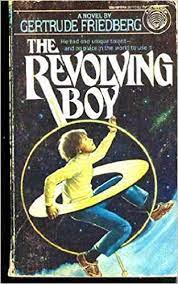
The Revolving Boy by Gertrude Frieberg, published 1966
I got the book sometime in late 1984.
It contains striking parallels to the following events in my life:
- Usually knowing where I am and which way is north
- Knowing how to navigate to any destination (above)
- The pin the tail on the donkey event (above - except he won the prize - I didn't)
- Locating the direction of a country on earth relative to where I am (above)
- Surround sound hologram (chapter 21)
- Built devices to transpose music
- A robot-steering game* using one-foot-square floor tiles - I used it to teach vector and GWBASIC graphics
- I taught permutations and combinations (above)
- I worked in chemistry labs
- I used, taught, and wrote programs to calculate Fourier transforms (below)
- As a former ham radio operator, I know about equipment radio telescopes use.
- I helped someone set up an amateur radio telescope.
- Arecibo radio telescope shut down.
- Green Bank radio telescope replaced with a new one.
* I started doing this before I read the book.

Blair is a company that sells clothing by mail-order.
My brother and I were looking at a Blair clothing catalog.
We found a pair of golf pants made of cloth having the print pattern seen at right.
My brother said "Those aren't golf pants! They're croquet pants! They match the stake at the end!
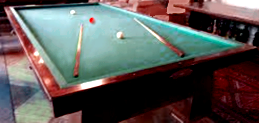
| VALUE | SI | PFX | SHORT SCALE | LONG SCALE | SI INV | PFX |
|---|---|---|---|---|---|---|
| 103 | kilo | K | Thousand | Thousand | milli | m |
| 106 | mega | M | Million | Million | micro | μ or u |
| 109 | giga | G | Billion | Milliard | nano | n |
| 1012 | tera | T | Trillion | Billion | pico | p |
| 1015 | peta | P | Quadrillion | Billiard | femto | f |
| 1018 | exa | E | Quintillion | Trillion | atto | a |
| 1021 | zetta | Z | Sextillion | Trilliard | zepto | z |
| 1024 | yotta | Y | Septillion | Quadrillion | yocto | y |
One of my students was from Spain, and could not comprehend the US federal budget in trillions of dollars.
Spain uses the long scale with one trillion = 1,000,000,000,000,000,000. = 1018.
I explained that Spain uses long-scale number names, while the US uses short-scale number names.
The US uses the short scale with one trillion = 1,000,000,000,000. = 1012.
The two number systems can be found here (and partially at right).
The inverse values add a "th" ending.
The long scale uses extra prefixes with "-iard" and "-iardth" endings.
To avoid confusion, use the metric (SI) prefixes.
Multiplying metric prefixes are capital. Dividing metric prefixes are miniscule.
Each metric prefix always means the same value anywhere on earth.
Incidentally, the game "billiards" is named after the long scale number name:
one billiard = 1,000,000,000,000,000. = 1015.
They said there were billiards of possibilities in three-rail billiards
(image right).
That would be quadrillions of possibilities in the short scale.

| CASE | SPANISH | OLDER ENGLISH | TODAY'S ENGLISH |
|---|---|---|---|
| Familiar Singular Subject | tú | thou | you |
| Familiar Singular Object | te | thee | you |
| Formal Singular Subject | usted | you | you |
| Formal Singular Object | le/la/lo* | ye | you |
| Familiar Plural Subject | vosotros | thous | you |
| Familiar Plural Object | vos | thee | you |
| Formal Plural Subject | ustedes | youse | you |
| Formal Plural Object | les/las/los* | ye | you |
| Familiar Singular Possessive | tuyo/a* | thy | your |
| Formal Singular Possessive | suyo/a* | your | your |
| Familiar Plural Possessive | vuestro/a* | thine | your |
| Formal Plural Possessive | suyo/a* | your | your |
* gender dependent
Many sources, including some religious and secular (including crossword puzzles) say there are special pronouns and verbs in the Bible that refer to God.
These references usually include the words "thee"", "thou"", "thine"", "hast"", "doest"", "shalt"",
A careful examination of the Bible shows that these words often refer to people other than God.
These words are found in older translations of the Bible, but not newer translations.
Many people will not use the newer translations because "God is not referred to properly in them."
I took four years of Spanish during my education.
The Spanish language has two different forms of words meaning "you".
- The word "tú" is the familiar singular subject pronoun for "you".
- The word "usted" is the formal singular subject pronoun for "you".
English USED to have familiar and formal forms for the word "you".
- The word "thou" is the familiar singular subject pronoun for "you".
- The word "you" is the formal singular subject pronoun for "you".
In the middle of the 19th century, English removed the familiar forms from general use.
This was because they were often used in demeaning ways by royalty.
This leaves us with just the word "you".
These words have nothing to do with revering God.
They are archaic familiar case words that are no longer used.
It is interesting that they used the familiar case to refer to God in the translations.
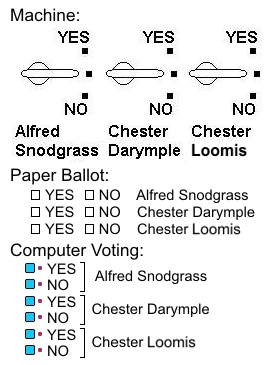
At the time I was tutoring finite mathematics at the university to help struggling students.
I was teaching about disjoint events (can't happen together) and independent events (don't influence each other).
One student asked me if votes in our elections were independent events.
I said, "No they are disjoint events. The same voter can't vote for two different candidates for the same office."
This started me thinking of how the disjoint Plurality Voting System (vote for only one) really works.
I noticed the disjoint Plurality Voting System's built in bias that favors the candidate most unlike the others.
I also noticed that the ranking systems can't tell when you stop liking and start disliking candidates.
Your ranking vote could help a candidate you do not like to win the election.
I started playing around with independent events instead of disjoint ones.
From this I devised the totally fair Independent Voting System (vote each candidate separately).
It is totally fair no matter how many candidates run for an office.
It is a nonadversarial system, so what one candidate does will not affect the others.
Now how do we get the politicians to use it?
- They won't see the faults in the Plurality Voting System, and
- They think the unfair ranking systems are fair
(or they like the idea of using the faults in either system to cheat).
They chant "One man - one vote!" as justification to use a defective Plurality Voting System.
It should be "One man - one vote per candidate!" for the Independent Voting System.
It is impossible for the voter to cast an invalid Independent Voting System ballot.
No primary election is needed with the Independent Voting System.
Negative campaigning does not work with the Independent Voting System.
The Independent Voting System is much harder to cheat.
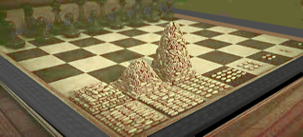
This started when someone gave me a Rubik's Cube.
I became interested in how to count and find probabilities on a Rubik's Cube.
I wrote a computer program that could compute using very large numbers.
My current version can work to 297 digits.
I wrote it to do plus, minus, times, divide, power, factorial, permutation, combination, and recombination.
Sample calculations - my favorite huge numbers:
- Tribbles in the grain storage bin - deriving what Spock said on Star Trek
("the Trouble with Tribbles" TOS).
Spock said a litter of 10 every 12 hours for 3 days.
Since the parent survived, that makes 11 times as many tribbles each time.
11 ^ 6 = 1,771,561
- 5-card hands in a deck of 52 cards (4 suits of 13 ranks).
This is the number of combinations of 52 items taken 5 at a time.
C(52,5) = 2,598,960
- Grains on a chessboard - one grain is on the first square, each next square is twice the
previous square.
This is 2 ^ 64 - 1
18,446,744,073,709,551,615
= 1.845*10^19 - 1 = 1.845E+19 - 1
The picture shows the piles up to square 11 (which is 2 ^ 10 = 1024). After that, the squares are too small.
- Indianapolis 500 possible finishing orders of 33 cars
This is 33! (33 factorial)
8,683,317,618,811,886,495,518,194,401,280,000,000
= 8.683*10^36 = 8.683E+36
- Rubik's Cube

This is 8! * 3 ^ 7 * 12! / 2 * 2 ^ 11
43,252,003,274,489,856,000
= 4.325*10^19 = 4,325E+19
There are 12 ways to assemble a fallen apart Rubik's Cube. Eleven will not solve to the START position.
- Rubik's Picture Cube
This is 8! * 3 ^ 7 * 12! / 2 * 2 ^ 11 * 4 ^ 6 / 2
88,580,102,706,155,225,088,000
= 8.858*10^22 = 8.858E+22
- Number of possible solved SUDOKU 9 × 9 grids
This is the sum of several different cases (not shown here)
6,670,903,752,021,072,936,960
= 6.671*10^21 = 6.671E+21
- Cryptograms with 26 letters with no cyphertext letters same as plaintext letters.
This is 25!
15,511,210,043,330,985,984,000,000
= 15.5*10^24 = 15.5E+24
- Possible BINGO cards.
This is P(15,5) ^ 5 / 11
552,446,474,061,128,648,601,600,000
≈ 5.52*10^26 = 5.54E+26 = 554 yottacards
- NCAA basketball tournament finishing orders with 68 teams if played fair
This is 68! (68 factorial)
2,480,035,542,436,830,599,600,990,418,569,171,581, 047,399,201,355,367,672,371,710,738,018, 221,445,712,183,296,000,000,000,000,000
= 2.480*10^96 = 2.48E+96
To play it totally fair would require 2278 games in a round-robin tournament.
With the unfair way it is played, 68 teams play on a tree with 67 games, plus one more game for 3rd place.
This is 2 ^ 68. The diminished number of possible outcomes is:
295,147,905,179,352,825,856
= 2.95*10^20 = 2.95E+20

This kind of sports tournament is inherently unfair unless only the winner is awarded a prize.
I used the same finite math methods I used to design the only totally fair voting system (see above).
See the above NCAA calculation (above) to see how unfair it is.
I noticed the following properties:
- No team in the half of the bracket the winner is in can take second place.
- No fair method is easily found to determine third place.
- I noticed that double elimination can't be fair when I had to play the same opponent twice in one contest.
- Finite math shows that a round-robin tournament is the only fair tournament. But it needs too many games.
- They use seeding to try to keep the best teams apart until the end. But it is guesswork.
- Reporters prefer bracket tournaments. They want a build-up to a final game climax that they sell papers with.
- Reporters hate round-robin tournaments. There is no climax. No winner is evident until the last game is over.
- They would rather have unfair tournaments than fair ones so they can sell papers with hype.
If brackets must be used, then do not award places other than first place.
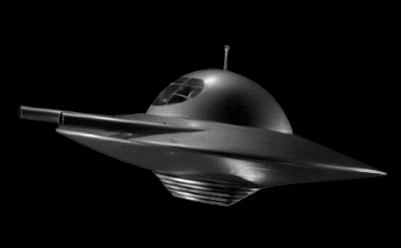
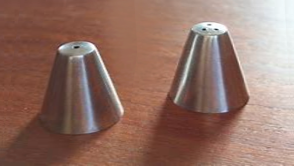
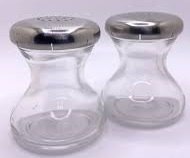
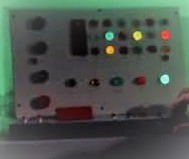


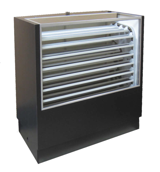
Prince of Space
- The prince's spaceship (right) is made from a handheld battery-powered
callus remover.
The bottom part rotates,
Captain Z-ro:
- The radar displays are oscilloscopes.
Star Trek:
- They bought futuristic-looking salt shakers to attract the salt vampire
(TOS - upper right).
But the TV audience would not recognize them as salt shakers.
So they got some glass ones from the studio cafeteria (near right).
Those conical shakers became Dr. McCoy's medical instruments.
- The original hand phaser was a TV remote with added parts.
- The computer Spock uses in Mirror Mirror and Wolf in the
Fold (TOS) is a traffic light test bench display box (right).
They changed the color lenses so it wouldn't look like traffic lights.
- The transporter control panel slide controls (TOS) are autotransformer
stage light dimmers.
- The huge cargo containers on starships (TNG) are 70 mm film transportation
cases.
- Geordi La Forge's V.I.S.O.R. prosthetic is a woman's headband.
- Worf's Bat'Leth (weapon) (TNG, DS9) is a large pizza cutter with the
handles on the wrong edge.
Star Wars:
- The long pipe with knurled fittings in the trash masher (ep IV) is a
giant copy of my metal scribe (right).
- The restraining bolts on C-3PO and R2-D2 (ep IV) are Greenlee metal chassis
hole punches.
- The colored rectangles on Empire service ribbons (right) are Radio Shack
light socket lenses.
- The cylinders in the Empire shoulder pockets are pocket flashlights. I have three
of those.
- The bomb used to destroy the shield generator (ep VI) is a ceiling-mount
smoke alarm.
Dune (1984):
- The glowglobes are wall-socket night lights I used to have.
- The holder for the weirding modules is a motorized jewelry display
case from the 1960s (right).
- The weirding module is a phone operator's mic connected to a
fancy door pull with devices.
- The hunter-seeker is a Radio Shack large clear electronic probe (metal rings
and bars added).
- The large discs on Baron Harkonnen's suspensor suit are Radio Shack
sealed-back speakers.
- Gurney's weapon (smugglers battle) is a grip strength tester with no
meter head. I used to fix them.
- The guildsmen wear old body bags that were found in an abandoned fire
station.

I was at the funeral of a relative when they had a problem:
The funeral home director called out to people at the funeral after the service ended,
"Does anyone here know where the (name) cemetery is and how to
drive to it?"
I was the only person in the room to raise a hand.
(The other friends and relations of the deceased didn't know because the cemetery plots were bought by an ancestor in the adjacent county.)
The director told me that the one employee who knew where it is was at home sick.
They put me in the driver's seat and the director sat next to me to explain any special rules.
I drove the hearse to the cemetery and put it right where they wanted it.

I was walking out from the house to the car when I saw a pink star in the sky (image is simulated).
Since this was very unusual, I went back inside and asked my father to come look at it.
As we watched it, the star became darker, more purple, and larger.
It then stretched in the east-west direction to about 5 times as long as it was wide.
A green glow then surrounded the center of the original position of the star.
We decided that it was something that had been launched in a rocket.
It continued to spread out and faded to invisibility.
I called the university Astronomy Department the next day to ask what we saw.
They said it was a barium cloud - a solar-wind experiment - released by a satellite.
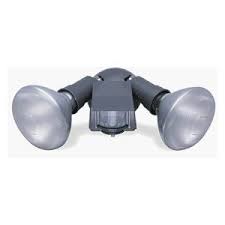
My house has such twisty paths inside that it is impossible to hear a knock at one door from the other end of the house.
I had the idea of using the x-10 remote control system to signal that people were at the door.
I gave each x-10 motion detector its own address, and gave the output signal the address 3 spaces higher.
Each output signal worked a receiver that rang a signal bell system and lit signal lights indicating which door.
Visitors were announced before they ever touched the door.
I am now contemplating using new motion detectors and transformers to run the signal system.
The original system failed because the power company started using the same frequencies to read meters.
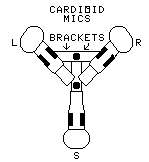
I set up this three mic design as shown as an experiment to record a solo vocalist and try to capture room reverberation.
I fed these into a simple mixer with the S mic feeding the L and R channels in opposite phase.
The soloist was about two feet from the L and R mics.
The soloist practiced the part a few times before the first take. Then we recorded the take.
I rewound the tape and played it through stereo monitor speakers. Then the following conversation took place:
Me: "Would you please stop practicing? I want to hear the tape."
Soloist: "That's not me. It's the tape!"
It sounded so real that I didn't realize it was the tape playing. I thought it was the soloist practicing again.

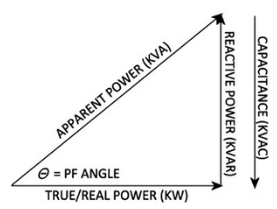
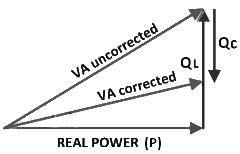

On November 9, 1965: I saw the news story on the New England blackout on TV.
In 1966, the Federal Power Commission report specified that relay Q29BD had tripped.
They did not find a definite reason for the trip.
They said possibly a sudden surge momentarily raised the power above 375 MW.
The object near the ground in the foreground of this picture is one such overwattage cutout relay.
The power was restored with the same equipment that was running at the time of the failure.
In 1969, I bought Scientific Study of Unidentified Flying Objects."
It has part of this report and an IEEE Spectrum report.
In my engineering job in 1983, I built a monitor to find instantaneous campus electrical power usage.
This power is measured in three components (right):
- watts (W): The product of volts and amperes in phase with each other
- volt-amps reactive (VAR): The product of volts and amperes 90 degrees out of phase
- volt-amperes (VA): The vector sum of watts and volt-amps reactive
- Power Factor (PF): W/VA = cos(θ)
The power supplied by the generators to a load is measured in watts (W or multiples KW or MW).
Reactive power is phase-shifted power, measured in volt-amps reactive (VAR, KVAR, or MVAR).
VAR is caused by AC power flowing into an inductor (e.g. an electric motor) or a capacitor.
The resultant in volt-amperes is the vector sum of the real and reactive power (VA, KVA, or MVA).
In May 1996, I read Scientific Study of Unidentified Flying Objects again and noticed these facts:
- Relay Q29BD trip setting: 375 MW (megawatts) and 160 MVAR (megavolt-amps reactive).
- This means either the 375 MW or the 160 MVAR could trip the relay.
- The actual power on the line was: 356 MW and approximately 160 MVAR.
- The relay tripped out when the reactive power exceeded 160 MVAR!
It was operating at the trip point!
- All it took was a small phase shift, not an overload, to trip the relay.
Since the MVAR was right at the trip point, starting a single large motor would have tripped the relay.
It tripped, then other relays on parallel lines tripped as more than 375 MW went through each one.
Suddenly unloaded, generators went out of phase with each other, tripping them on high MVAR values.
Correction capacitors on power lines cancel the inductive phase shifts from large motors (upper right).
The same thing happened again in 2003.
This time, a correction capacitor set (e.g. right) was ordered turned off
by a public official for inspection.
This happened when the official demanded it, regardless of the needs of the
power system at the time.
Without the corrector network, the system operated at the trip point
and tripped out on high MVAR.
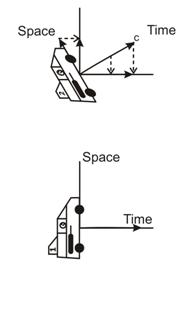
Space-time has 4 dimensions and is flat.
Everything travels at the speed of light. There is no other speed in the universe.
The Relativity Invariant:
c2 = vx2 + vy2 + vz2 + vt2
Where:
c = the velocity of light
vx = observed velocity in the x dimension
vy = observed velocity in the y dimension
vz = observed velocity in the z dimension
vt = velocity in the time dimension as observed by passage of time
The direction any frame of reference is traveling is Lorentz-contracted to zero length as observed in that frame.
The direction any frame of reference is traveling at lightspeed in is the time dimension for that frame of reference.
The other three orthogonal dimensions are seen in the frame of reference as space.
Any observed velocity slower than lightspeed (including at rest) is a vector difference between two lightspeed vectors.
Objects at rest relative to each other have parallel lightspeed vectors.
An observed acceleration is actually a changing of the angle between the lightspeed vectors of objects.
Part of matter's motion is particle rotation and revolution.
Because of this, material objects travel linearly at slightly slower than lightspeed.
This slowing distorts space-time, causing gravity.
This also shows that faster-than-light speeds, antigravity, and backward time travel are impossible.
I later developed trigonometric methods to calculate relativity, simplifying the work.
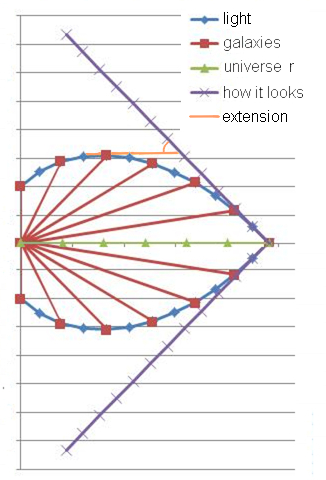
Scientists are reporting that the speed of expansion is getting faster and faster, based on spectral emission lines.
I was shown (above) that everything in the universe travels at the same speed - the speed of light.
The apex at the right of the diagram shows the observers (us).
The red lines show the paths of the galaxies from the big bang to their positions as they are visible today.
All of these galaxies are traveling at the speed of light away from the point of the big bang.
The blue lines are the actual paths of the light from being emitted by a galaxy to us.
The violet lines show the line of sight we appear to have when looking at the galaxies along the blue lines.
The more bent the path of the blue line from a galaxy to us, the more the spectra are redshifted.
The orange line is used to calculate the angle between the emission of light and its being observed:
- At the galaxy, the orange line is tangent to the blue line.
- The angle between the orange line and the violet line is the angle of vision.
- This angle determines the amount of redshift.
The more the spectral lines are redshifted, the slower the universe appears to be expanding at that galaxy.
The farther away (and older) a galaxy is, the slower it seems to be expanding.
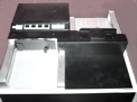
Documation
card reader
During the Florida recounts, they kept mentioning hanging chads and dimpled chads on the punch cards used for voting.
A chad is the little chip of cardboard that falls out when a hole is punched in a card.
The Democrats were claiming that the dimples found in the cards were voter attempts to vote.
The problem was that the punching stylus was rectangular, while the dimples found on the cards were round.
Then I saw one of the suspect card readers on TV. It was the same Documation card reader I used to service.
I remembered the recommended test to see if they needed cleaning (above):
- Run a deck of 30 cards through the reader 30 times.
- Look for dimples on the cards.
- A dimple indicates the reader needs cleaning.
Those round dimples were not attempts to vote. They were caused by very dirty card readers.
One reason the readers were dirty was that Al Gore had banned the only cleaner (freon spray) approved by Documation.


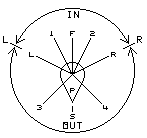
This encodes for any "Regular Matrix" surround sound, including:
Dolby Surround, QS, Electro-voice, and Dynaco.
Part of a typical mixer channel strip with a sub 3/4 selector is shown.
My encoder is inserted into the group (sub) inserts 3 and 4.
Groups 1 and 3 are panned left. Groups 2 and 4 are panned right
(Some mixers do this by default).
Groups 1 and 2 bypass the encoder circuit, so they mix normally.
Groups 3 and 4 pass through the encoder, so they mix in reverse phase.
The sub 3/4 selector selects front (released) or back (depressed).
To encode in the front of the surround image, select sub 1/2 (release).
To encode in the back of the surround image, select sub 3/4 (depress).
The channel strip pan pot positions the part in the left-right direction.
Since each channel strip is set independently, all parts are encoded simultaneously.
A Dolby Surround panning diagram is shown at right. Phase select is IN (1/2) or OUT (3/4).
Note: Make sure that no front-encoded channel has any sounds also in any back-encoded channel.
Monitor the mix through the appropriate decoder.
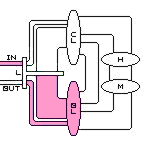
Brain cycle
We were doing human reaction time trials in the motor control lab where I worked.
The experiment had a subject push a start button, then push a stop button when a light turned on.
I kept seeing that reaction times of multiple trials were spaced in groups at multiples of a value of about 1/4 second.
I started looking for something in the computer causing a spaced interval in the timings of taking samples.
After using a randomized timer and not observing such intervals, I concluded it was not in the computers.
I then compared the intervals in different subjects. Each subject had a different period between the groups.
The periods ranged from about .15 second (6.7 Hz) to about .40 seconds (2.5 Hz).
This is about the range of brain wave frequencies in normal adult humans (simplified brain diagram shown).
The timing of the start button, noticing the light, and pressing the stop button are synchronized to the brain waves.
Each item is timed to the end of a cycle of the brain. This is what bunches up the
reaction times.
e.g. The light comes on. But the subject doesn't notice it until the end of the
next brain cycle after visibility.
Then the brain must issue the order to press the button, using one or more brain
cycles.
This can cause errors in such reaction-time dependent systems as using stopwatches and VASCAR.
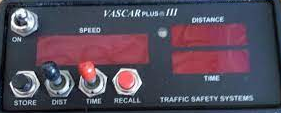
VASCAR control panel
VASCAR is the Visual Average Speed Computer And Recorder (used by police to measure highway speed).
It must be assumed that the + or - error in VASCAR caused by this is -.40 second (the worst case).
| ACTUAL SPEED | 2 sec ERROR (20%) | 4 sec ERROR (10%) | 5 sec ERROR (8%) | 10 sec ERROR (4%) | 20 sec ERROR (2%) |
|---|---|---|---|---|---|
| 30 mph | 36.0 mph | 33.0 mph | 32.4 mph | 31.2 mph | 30.6 mph |
| 40 mph | 48.0 mph | 44.0 mph | 43.2 mph | 41.6 mph | 40.8 mph |
| 50 mph | 60.0 mph | 55.0 mph | 54.0 mph | 42.0 mph | 41.0 mph |
| 60 mph | 72.0 mph | 66.0 mph | 64.8 mph | 62.4 mph | 61.2 mph |
These are the worst case errors for the times between start and stop marks caused by officer reaction times.
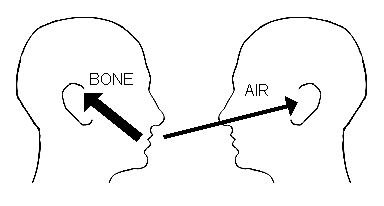
When I was doing sound, many of the performers complained that their voices sounded wrong in the recordings.
I told them that the recordings sounded just like their live voices. They would not believe it.
Most of them were demanding that I turn down the treble and increase the bass in
their voices.
- But if I did this, the entire recording sounded muddy.
I asked if they knew why the old movies have actors with muffled voices. Most said it was the ancient sound systems.
- The screen actors guild demanded what was the academy curve to cut treble and boost bass on all vocals.
- The result was that we got union-enforced muddy-sounding movies for years.
Then I played a tape of all of them singing together. I asked each one how each of the others sounded.
- Each one said that all of the others sounded fine.
- Then each one of them said his/her own voice sounded squeaky and weak in the recording.
Then I played the tape again with the treble cut and the bass boosted.
- Each one said that all of the others sounded muddy and dull.
- Each one of them said his/her own voice sounded normal.
Then each one wanted only his/her voice altered, but not the others.
- I explained that I want a recording where other people hear the voices sounding normal.
- "If your voice sounds normal to you, it sounds muffled to everyone else."
The explanation is that people hear their own voices by bone conduction in the skull,
not through the air.
- The bone conduction emphasizes bass and reduces the treble you hear.
- Only you hear your own voice by bone conduction. Every person hears
only his/her own voice that way.
- All other voices you hear are heard through the air. And everyone else hears
your voice through the air.
- So if we cut the treble and boost the bass on each voice, then everyone
else hears their voices as being muffled.
Vocalists must learn how they really sound in a recording and accept that it is a real reproduction of how they sound.

I did an experiment to show why people do not like their driver's license photos.
I had a friend who hated to see pictures of herself. She said they were always ugly.
I took a photo of her without her knowing I took it.
- Then I printed the photo with my computer. I also mirror-reversed the photo and printed that.
- I showed her the two prints. She picked up the mirror image print and said "Now that looks like me!"
Then I explained that the print she liked was a mirror image of the other print.
The explanation is that most people know what they look like from what they see in a
mirror.
- So the self-images most people have are mirror images of themselves.
Try holding your driver's license in front of you and look at it (and yourself) in a mirror. It will look better to you.
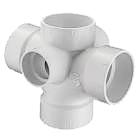
In the dream, I was helping someone put a new plastic-pipe sewage drainage system in his house.
There was one place in the plan where 6 sewer pipes come together at one point.
The owner bought a six-way cross fitting that cost over $60 to connect those pipes.
We were in the basement trial-fitting some of the parts together in place before cementing them together.
I had just fitted the six-way cross onto an existing horizontal piece to measure for the length of a new vertical pipe below it.
The owner's wife called him from the basement door. He went upstairs and then outside.
The telephone rang and I ran away to answer it at the other end of the basement. It was a wrong number.
As I was walking back to the work area, I heard the theme music from the movie "Jaws".
At the climactic part of the music, that expensive fitting fell of the pipe and shattered on the concrete floor.
I woke up laughing my head off.


I was repairing a broken cable in the Motor Control lab in the Kinesiology labs when I saw these diagrams on the whiteboard.
When the professor came in, I asked him what the diagrams were of.
He told me they were the myelin sheath (green) on a nerve cell's axon (output) and the electrical model of the sheath.
I said, "See this coaxial cable I fixed? That diagram is also the model of the properties of this coaxial cable."
He said that the myelin sheath protects the nerve impulse from noise and helps the signal get there faster.
Then I said that the metal shield surrounding the center conductor in the coax cable does exactly the same thing.
Note that the real model has an infinite repetition of the circuit along the length of
the cable.
The drawn diagram shows only two repetitions.
This is how humans and animals have many long axons running through the spinal cord in both directions without noise and crosstalk.
It's also how the signal snake from the stage to the mixing console at a concert works without noise and crosstalk.
Multiple Sclerosis is failure of the myelin sheaths so the signals get mixed up.
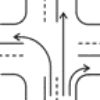
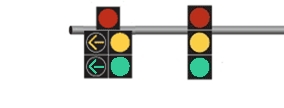

In 2005, the city reported that the intersection had the highest accident rate in the city.
Most of these accidents occurred at night (when traffic is light).
The signal had a single shared left turn face for westbound traffic on 10th (top is west on this diagram).
The left turn was recalled every cycle because there was no turn lane.
Woodlawn had an actuated phase, turning green only when traffic was waiting.
A yellow-trap occurred on every cycle where Woodlawn did not get a green (in the diagram, the red arrow is a crash).
Eastbound left traffic was unaware that when the eastbound signal was yellow, the westbound signal could still be green.
DANGER: NEVER assume that oncoming traffic has the same color signal that you have.
After I told them, they set the signal so the left turn arrow did not display unless traffic was present on Woodlawn.
I found out about the flashing yellow arrow signal for preventing yellow trap in 2006.
The city replaced the signal with one with flashing yellow arrows left turns in 2016 (lower signal diagram).
Properly installed flashing yellow arrows prevent yellow trap for any sequence.
This is true only if all approaches have flashing yellow arrow faces and they are correctly set up.
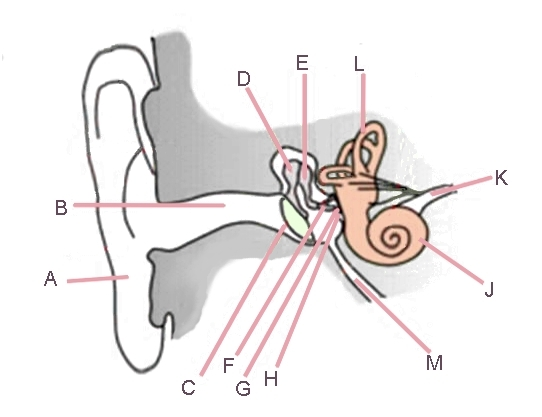
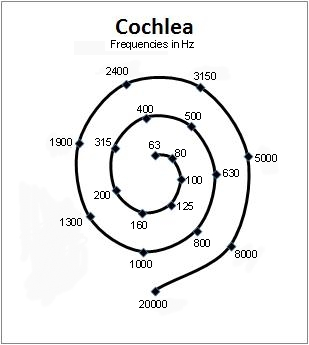
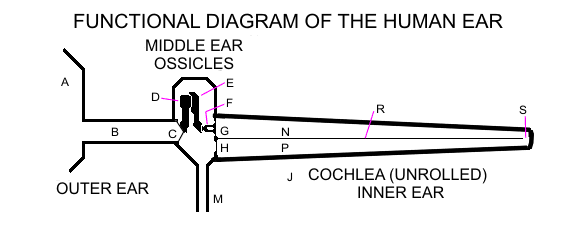
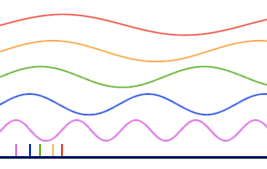
The purpose of the cochlea is to sort frequencies and measure amplitudes at each frequency.
The Fourier transform is commonly used to convert a time spectrum to a frequency spectrum.
Every non-linear function can be represented as a sum of (infinite) sine waves like this:
 Where: N = number of samples n = current sample
Where: N = number of samples n = current sample
k = frequency (Hz ... 0 Hz to N-1 Hz)
Xn = amplitude at time n Xk = amplitude at frequency k
i = √(-1)
This mechanical doohickey sorts frequencies by finding resonant nodes on membrane R.
The distance from oval window G to resonant peak N on membrane R finds the frequency.
Sounds cause membrane R to bounce up and down at resonant points.
The lower the frequency, the longer the distance between G and N is.
High frequency nodes on membrane R are near the oval window G.
Low frequency nodes on membrane R are near the helicotrema S.
The atonal lowest frequency sounds vibrate the entire membrane R up and down.
Infrasonic frequencies pass through the helicotrema gap S instead of making nodes.
Consonant (good-sounding) sounds make gentle ripple patterns on membrane R.
Dissonant (awful-sounding) sounds make violent ripple patterns on membrane R.
Nerve sensors are placed all along membrane R.
Each sensor responds to the resonant frequency of membrane R at the point where it is.
The cochlea (J) is actually coiled up, as in the top two diagrams.
The sound-sorting process is illustrated at right.
Distance to the first peak in the waveform is used (marks on graph baseline - right).
This peak finding is exactly what the formula above does.
You have two of these mechanical Fourier-transform frequency sorters - one in each ear.
Now you know how you can hear sounds up to 20 KHz using nerve cells that run at up to 20 Hz.
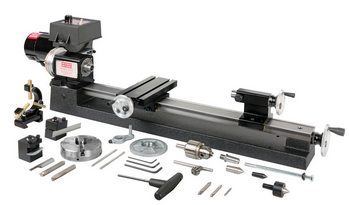
One of the scientists where I worked came to me with a hand drill, several boxes of
pingpong balls, and
some dented, smashed, deformed, and impaled pingpong balls.
He told me "I need one circular hole this size (points at the drill) in each of these pingpong balls."
After considering the problem, I chucked a center drill bit the same size in the tailstock quill of the shop lathe.
Then I chucked a pingpong ball in the headstock spindle chuck, just tight enough to keep it from slipping.
I spun the ball with the chuck at drilling speed counterclockwise as seen by the tailstock.
Then I fed the tailstock quill to plunge the stationary center drill into the ball.
Within half an hour, I had drilled all of his pingpong balls.
This made a nice neat and accurate hole in each ball. The ball spun, not the drill bit.




I was assigned to find the many ways that bad science occurs.
I found there are several ways bad science can happen:
- The study has not been verified before being given to the press.
- The investigators are trying to prove what they already believe to be true (see image).
- The investigators do not know enough of the science or mathematics needed for the study.
- Using predicted results of an effect to prove the existence of the effect.
- Collecting the wrong data, collecting the wrong amount of data, or culling the data.
- Collecting only a small amount of data to stay within budget.
- Using a nonrandom sample when a random sample is required.
- Using the wrong data type for the data collected.
- Using the wrong statistical method for the kind of data collected.
- Pressure is exerted by others to finish by a certain date, find a certain outcome, stay in a budget, or apply a certain bias.
- The researcher is emotional about something or is afraid of a possible outcome.
- Political pressure (including funding cuts) is applied to those doing the study.
- Ignoring ceteris paribus rules (next item).
- Some factor was omitted.
- Results were faked to find a certain outcome.
- Results were faked because an experiment was damaged and a student didn't want to have to repeat the class.
- People disbelieved the result because it was not politically correct.
Recognizing Bad Science shows the major sources of bad science.
Examples of Bad Science gives real cases where bad science caused erroneous results.
Hereditary Homosexuality has been the source of more of the bad science reported than any other subject.
Too many "scientists" screamed "bad science" any time president Trump mentioned science.
- They hated him so much that they refused to believe he was quoting real science.

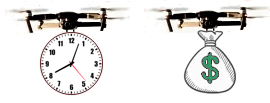
Ceteris Paribus means that everything except the item being studied must be exactly the same during the entire study.
If the computer fails during the study, you can't buy an identical new replacement. They are all gone.
If the computer needs replacing during the study, the operating system will be different on the new one.
The IT department wants to upgrade all computers every 3 to 5 years. Ceteris Paribus means nothing to them.
If the computer is replaced, the old data collection hardware will probably not work with the new one.
The software you are using will probably not work on the new computer.
If you buy identical computers and store one as a replacement, the parts in it will fail shortly after the original fails.
So all of the time, money, work, and effort already in the study are wasted and you can't do anything about it.
The IT industry does not care about anyone doing studies longer than 10 years. They want your money to upgrade.
They don't care that science is destroyed by their selfish marketing decisions.

I was doing analysis of variance (ANOVA) on the various factors in the economy to find out which ones were related.
When I compared economic growth to government spending, I got mixed results - some cases related, and some not.
The factor that I found was most related to economic growth was work done to make useful products for the open market.
Work is the engine that drives the economy.
This explains why socialist plans never work. Socialism can't work because it discourages work.
Notice how the people who want the "equality" of socialism want it because they think they won't have to work as much.
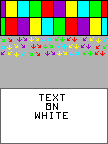
Accounts say that medieval churches with colored stained glass windows had white light inside to read by.
Renaissance artisans attempted and failed to create such stained glass windows.
It was accepted at the time that the art of how to do this was lost.
I found it!
I have been in several modern churches with this effect.
People going to those churches don't know they have something special.
There is no real secret to this. Modern color theory provides the answer:
- The windows must have enough different colors to let in most wavelengths of light.
- The colors must be balanced enough that they mix on white surfaces to produce visibly white light.
- All of the colors must come from enough directions to prevent color shadows.
- The glass must be translucent, not transparent.
The translucent glass scatters the light from the window in many directions.
The scattered light from all windows then lands on the reading material as white light.
Transparent stained glass does not scatter the light, so the effect does not happen.


The box selects outputs for 10 different speakers, each with its own amplifier.
There are outputs for:
- F - Front (placed as center front)
- LM RM - Main (left and right front)
- LW RW - Wing (left and right side)
- LP RP - Posterior (left and right back)
- B - Back (center back)
- Z and N - Vertical (zenith and nadir)
Selections are there for DS, RM, QS, EV, DQ, SQ, EU, UQ, BMX, H, HR, UHJ, and CS.
Each selector switch provides an off position and positions for its speakers to play each matrix.
Matrix coefficients are variable for LM, RM, LP, and RP channels using the blend controls.

There I met the love of my life. We had known each other before, but just casually.
We chatted while she was waiting for her brother to pick her up.
I started driving her home from work every day.
13 months later, I asked her to marry me.
7 months after that, she became my wife.
I realized that if I had made any career choices different than those I made, I would never have met her.
10 years of marriage without even one fight!

My wife and I were working at a summer Bible school.
I heard on the radio that Venus was transiting the sun.
I got a pair of binoculars out of the car.
I aimed the binoculars at the sun low in the west and focused the image from the eyepiece on the building side.
DANGER: NEVER look at the sun through binoculars or a telescope. It will destroy your vision.
Venus is the black dot near the bottom of the sun image. The image we saw was about an inch in diameter.
As the children and teachers came out of the building, I showed them the image of Venus crossing the sun.

My previous two cars had a way to lock out first gear for winter driving.
I needed a car in a hurry and 'Cash for Clunkers' took away all of the cars with first-gear lockout.
I made Second Gear Start for a 2002 Pontiac Bonneville to get this needed winter driving function.
It locks out first gear in the automatic transmission to prevent wheel spin.
A switch enables it. The white light tells me that the 2GS switch is on.
The colored light tells me which speed the transmission selected:
(dark = 1 red = 2 yellow = 3 green = 4)
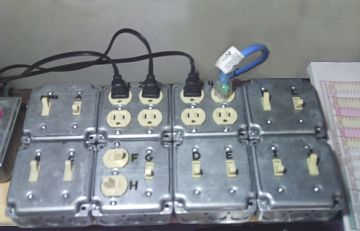
It can select any series combination of 2 to 4 120V loads.
It can select any parallel combination of 1 to 4 120V loads.
It can also produce several other combinations of series-parallel and parallel-series circuits.
(Note that the order of components in series circuits is forced.)
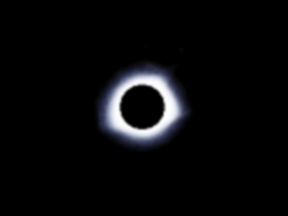
I had been waiting since 1963 to get a chance to see a total solar eclipse.
This one was still at least 200 miles away. My wife and I decided to go.
I built a solar projector with my small telescope, a tripod, white cardboard, and an easel.
DANGER: NEVER look at the sun through binoculars or a telescope or stare at the sun. It will destroy your vision.
Fun Trying to See the 2017 Total Solar Eclipse
The fun part was getting to and from the eclipse. What a mess!
I took that photo during totality.
(Right-click and choose 'View Image" for bigger version.)
And guess what. The next one in 2024 goes right over my house.

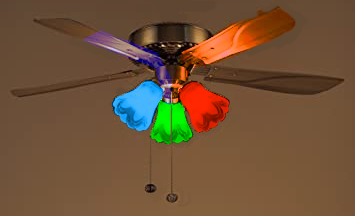

This works for protanomaly (red-weak), deutanomaly (green-weak), tritanomaly (blue-weak),
and red-green indistinction.
It does not work for protanopia (red blind), deutanopia (green blind), tritanopia (blue
blind)
cone blindness, or total color blindness.
The lamp has colored LED bulbs in red, green, and blue - the primary colors of light.
Be sure to get real colored LEDs, not white LEDs behind plastic color filters.
These provide light with gaps in the spectrum in the yellow and cyan part of the spectrum.
The defective retinal pigments are confused by light in the yellow and cyan parts of the spectrum.
All other light sources must be turned off for this to work.
Ordinary white lights can be provided for times the special vision light is not needed.
Separate switches can be provided for each color.
I also put this special lamp into a ceiling fan.
A tricolor TV set also provides the correct colors on the screen and for room light (using a white raster).
A tricolor computer monitor showing a white screen works too.
En-Chroma makes glasses with sharp-cutoff filters that remove yellow and cyan light that work anywhere.
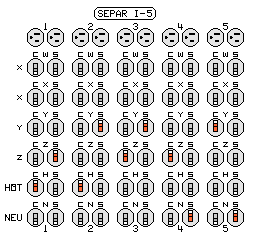
It can connect any possible permutation of the devices in any series, parallel, or combo of series and parallel.
The permutations include the polarities of the devices.
It is expandable for any number of devices.
For n devices, the circuit needs:
- Connection points for each device (normally two - outlet at top of each column in
picture)
- Only one device outlet is needed. Duplex outlets are shown because of their much lower cost.
- For screw base lightbulbs, the connections are marked:
C for the center terminal
S for the screw shell- The C goes to the short outlet slot, and the S goes to the long slot.
- Portable lamps are sold with polarized plugs with this standard.
- One column of switches for each device connection point (normally two columns per device)
- At least n-1 rows of switches for interconnection buses
- at least two rows of switches for power connections
A power switch for the entire box can be added.
This switchboard is not polarity-safe and is not neutral-safe (see below).
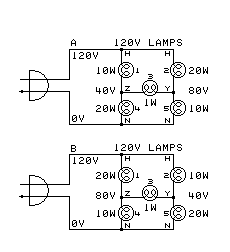
NEUTRAL-SAFE: If the neutral connection to a lamp is opened, the hot connection must be disconnected too.
POLARITY-SAFE: A lamp screw shell must be kept at a voltage closer to neutral than the center terminal voltage.
The circuit shown is a possible switch position of a switchboard that proves this fact.
The switches on the board in the item above are set to make this proof circuit.
Notice that the conditions for polarity and neutral are met in the top version of the circuit.
The only difference between the first version and second version is that bulbs were traded between the sockets.
The switches are still in the same positions for both diagrams.
Notice that, in the bottom version, lamp 3 has the closer-to-neutral voltage on its other terminal.
This means that no switchboard for all series/parallel combinations can prevent a polarity or neutral error.
I wasted years trying to design a switchboard for all series/parallel combinations with no polarity or neutral error.
Any switchboard circuit that provides bridge circuits such as this cannot be either polarity-safe or neutral-safe.
A switchboard that is polarity-safe and neutral-safe can be made, but it cannot do all series/parallel combinations.
Sensors that notice polarity and neutral errors could be used to shut down the switchboard if they happen.

I was trying to train my mind to not notice race. I found I could not do it.
The part of my mind that recognizes people puts out interruptions when people of other races are seen
I was unable to stop these interruptions. They are a built-in part of the recognizer hardware.
The original evolutionary purpose of this was a warning of interacting with some other specie. It misfires with race.
What I did was redirect those interruptions to see good things instead of bad things.

- Schism
- Gershwin
- Melchizedek
- Kinesiology
- Cesium
- Shih Tzu
- Schnitzel
- Guzoo
- Kazoo
- Schist
- Cashew
- Smersh
- Catharsis
- A shoe
- Shasta
- Honshu
- Schlitz
- Thesaurus


LM - F - RM
| Z |
LW N RW
| |
LP - B - RP
| |
LD RD
The new box selects from the 10 speakers signals to be delayed to fix the side images.
The outputs for these are selected to send to the delay speaker on the opposite side:
- F - Front (placed as center front)
- LM RM - Main (left and right front)
- LW RW - Wing (left and right side)
- LP RP - Posterior (left and right back)
- B - Back (center back)
- Z and N - Vertical (zenith and nadir)
- LD RD - Delay (left and right)
Selections are there for off and all levels at positive and negative phases.
The delay speakers are placed several milliseconds away or placed in delay tubes.
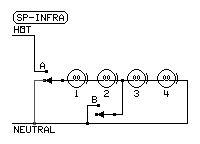
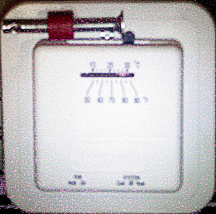
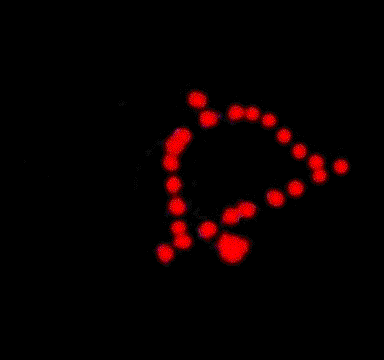



Feet Heater
Floor Warmer
Another Floor Warmer
An Air Stirrer
A Window Air Conditioner Thermostat Controller
Timer Control of Air Conditioner
Screw Vernier Thermostat Adjustment
Infrared Radiation Replacer for Cold Rooms
Traffic-Actuated Stairway Lighting
LED Christmas Light Circuits
Surround Sound Field Miking Techniques
Surround Sound Decoder and Side Image Corrector
Circuits for New Technology Bulbs
Selecting Between Series and Parallel
Special Purpose Lamps
Full-Spectrum LED Lamps
Color Vision Correction LED Lamps
Simulate Defective Color Vision

LM - F - RM
| SBAR |
| |
| |
LP ------ RP
The soundbar provides the crossed delays to fix the side images.
- F - Front (placed as center front)
- LM RM - Main (left and right front)
- LP RP - Posterior (left and right back)
- B - Back (center back)
- SBAR - Soundbar with crossed delay
The LW and RW Wing speakers are not needed because the soundbar fills in the gaps.

This one went right over my town. We did not have to travel.
I took my solar projector (see above) to a local nursing home and rehab center.
Patients there got an extra treat (They also gave everyone eclipse glasses).
DANGER: NEVER look at the sun through binoculars or a telescope. It will destroy your vision.
I took this photo of the eclipse sunset effect during totality.
(Right-click and choose 'View Image" for bigger version.)
The next one is in 2044.
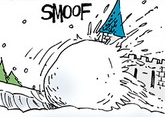

I have been in two tornados and have seen three more.
I was struck by lightning once from a storm over 30 miles away.
I was in an earthquake that made concrete-block grating noises in the house.
The temperature dropped to 23 °F and it snowed 6 inches in the middle of July in 1979. Half an hour later, it was all gone and the temperature was 78 °F.
I saw auroras three different times, in 1958, 2002, and 2024.
I was stuck in one elevator when the doors wouldn't open due to a tangled belt.
I was stuck in a room accessible only by elevator when the elevator lost power (the other exit was blocked by a construction fence).
I had just walked under a set of power lines when a tree fell and brought them down 6 feet behind me.
I have seen lightning strike and explode a tree.
A tree fell on and damaged my house during a brief downburst wind.
Three tree branches from different trees fell on cars in my driveway in different years and damaged them. One was totaled.
Two tree branches fell on the same car on different dates in parking where I worked. Both broke the windshield. This car was also one of the cars above.
The tie rod of a pickup truck broke, causing the truck to crash into and total that same car parked in the driveway.
On three separate dates, cars had engine failure, turned out of traffic, and crashed into the same lamppost in my yard. The post is 20 feet from the road.
In each of the three auto accidents I was in as a driver, the other driver caused the accident by using a cell phone instead of paying attention to traffic.
Lightning struck the power pole near my house. The lights in different rooms began changing brightness. The ground strap in the meter had failed.
I saw two huge sundogs one morning. Each one was at least 6 times the height of the sun in the sky (similar image right).
I heard a loud boom caused by a meteor entering the earth's atmosphere.
I have been in 6 recessions. Each one was caused by Democrat overspending.
I got to drive my car on the track at the Indianapolis Motor Speedway.
My grandparents had a sleigh when I was young. We rode it in winter snows until the county paved the road in front of their farm. It couldn't go on pavement.
My aunt raised horses. She had a racing sulky and I got to drive it.
I built a tunnel in a huge pile of snow.
I had to shovel 12 inches of "partly cloudy" off the driveway.
One year a couple of friends and I built a bobsled run out of ice in the yard.
I have a box of mismanufactured hardware and parts I have gotten over the years.
There are screws and nuts without threads, a screw without a slot, a nut and
a washer without holes, and molded plastic parts with missing areas.
I was assembling a hanging light fixture and one part had the countersink for the flathead bolt on the wrong side.
I have seen and heard a car battery explode when the jumper cables were connected backwards.
I saw a garbage truck on fire as it drove down the road. I flashed my lights to stop it.
I was at a wedding where everything went wrong:
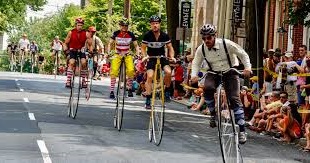
The government scheduled bicycle races around the block containing the church.
Nobody told the church.
Wedding guests had to park blocks away and walk to get to the wedding.
The race spectators ate the food set out on tables on the church lawn for the
reception.
It was hot. The church air conditioner failed. A groomsman fainted from the heat.
The caterers went to get more food and had to wait for a gap in the races to
bring their truck in.
A loud blaring PA calling the race and giving race statistics drowned out the
service through open windows.
At the reception (moved inside), the bride overthrew the bouquet. I was in a
food line and it landed in my plate.
The garter landed on a ceiling beam. They had to get a ladder to get it down.
The specially decorated car was barricaded inside the church parking area.
Just as the couple left in her parents' car, the race ended and the streets
were jammed with spectators' cars.
Caught in the traffic jam, the couple missed their plane.
Because they arrived on a later plane, they lost their hotel reservations.

Vice Presidents (before they were Vice Presidents): Dan Quayle and Mike Pence
Senators: Richard Lugar, Todd Young, and Dan Coats
Astronauts: Alan Shepard, Gus Grissom, Scott Carpenter, Ken Mattingly, Ken Bowersox, and Joe Tanner
Scientists: Marlin Perkins, J Robert Oppenheimer, J Allen Hynek, David Koceja, Joel Stager, and Doc James Councilman
Inventors: Sarkes Tarzian (TV), and Peter Scheiber and David Hafler (matrix quadraphonics)
Race Drivers: Rodger Ward, A J Foyt, Parnelli Jones, Al Unser Sr, Ed Carpenter
Musicians: Jimmy Dean, Melanie, Bobby Helms, Ella Fitzgerald, Duke Ellington, Peter Paul and Mary, Donna Fargo, Terri Bewley, David Baker
Entire musical groups: Roadmaster, Audio Adrenaline, Newsboys, Apologetix, Third Day, Skillet, Tommy James & the Shondells, Geoff Moore & the Distance
Other people: Corrie ten Boom, Joni Eareckson Tada, David Brickner
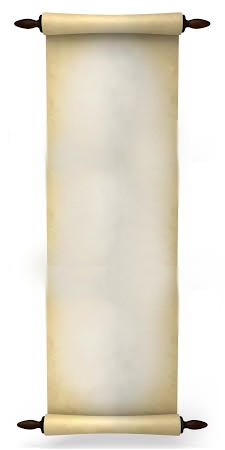
The Principal Principle: Government should be last, not first.
Life is a dirty trick.*
Without work, this stupid planet cannot sustain any human population.
Without profit, a company has absolutely no reason to hire.
Actions speak louder, but politicians won't shut up.
Ancient utopias ran on slave labor. That's why no utopias exist today.
The only source of wealth is work.*
You do NOT have the right to freedom from being bothered, offended, or annoyed.
If you got a house for free, someone else lost a lot of money.
When you perfect a foolproof device, they perfect better fools.
You can't fight against God and win.
A CD player is as useless without CDs as the CDs are useless without a player.
Every time you want to observe a rare astronomical event, it will be cloudy.
With n mousetraps, the (n+1)-th mouse gets all of the cheese.
When Democrats have no argument, they use pejoratives, innuendo, prevarications, obfuscation, and namecalling.
Wage and price controls never have the intended effect.
Side effects of regulations to help the poor always hurt the poor.
Raising the minimum wage inflates the money instead of helping the poor.
The purchase price of a product MUST pay for all labor, materials, utilities, and taxes paid to make it.
To raise the standard of living of the poor, cut taxes - raise the standard deduction.
Those who want to defund the police want to commit crimes without being caught.
Those successfully cheating at elections destroy the opposition ballots. This leaves no evidence.
They can't recount the ballots the cheaters totally destroyed. The voters who cast them lost their votes.
Democrats believe that they should never have to lose an election. Isn't that cheating?
Republicans promise things that can actually be done. The winners win by promising the impossible.
Republicans believe in and obey sexual morality. That's why there are more Democrats.
Democrats try to solve every problem by being N-I-C-E. It never works. It always makes a mess.
The science just tells us what can happen. But only belief systems tell us ways to do something about it.
The only known totally fair election system is not used in any elections. Does this mean the officials want to cheat?
Aren't taxes just legalized theft?
High taxation makes the products shoddier.
Businesses pay no taxes at all. They pass them on to consumers in higher prices and lower wages.
"Palestine" was the Latin word for "Philistia" (there is no "f" or "ph" sound in Latin). So Palestinians are Philistines.
Socialism does not work because it discourages people from wanting to do work.
This is proved by the worker shortage caused by the extended and
supplemental pandemic unemployment payments.
The default afterlife destination is hades.*
Atheists want there to be no afterlife. They will get hades instead.
They can't design a record changer that plays odd sizes, randomly intermixes sizes, repeats any record, plays a single record, and doesn't touch the grooves.
satan is a Democrat because he wants what Democrats want.
The highly salaried artisans of the past have been replaced by technology (e.g. portrait artist replaced by the camera).
Most of the trouble in this world is caused by people trying to get something for nothing.
* Without God.